Forces
Chapter overview
2 weeks
This chapter introduces learners to the concept of a force. Learners would have been exposed to some of the concepts around forces in previous grades, for example:
-
Gr. 8 Static electricity introduced learners to friction and electrostatic force; and
-
Gr. 8 Energy transfer in electrical systems introduced learners to the attraction and repulsion forces between magnets when looking at the magnetic effect of an electric current.
Learners will discover that there are two main categories of forces, namely contact and non-contact forces. They will be introduced to the concept of force fields. This chapter has many opportunities for getting the learners to engage physically with the concepts. Have learners pull and push objects and move each other around the classroom or outside in the school grounds. Have them push against buildings to experience the resistance offered by surfaces. Allow them to walk on different surfaces and feel the effects of friction.
There are many tasks included in this chapter. You might not have time to cover all of them. Some are extension tasks and some tasks are revision from Gr. 7 and 8. You will need to assess the requirements and capabilities of your class in order to decide which tasks to perform. There is a lot of content to cover in this chapter and many concepts form the foundation for what learners will cover in Physical Sciences in Gr. 10-12. You might need to spend more than the allocated 2 weeks of time that is specified in CAPS. Some of the other chapters in this term might not require as much time.
 Did you know that these workbooks were created at Siyavula with the input from many contributors and volunteers? Just turn to the front to see the long list! Read more about Siyavula at our website:[link]www.siyavula.com. You can also sign up at our community page if you would like to stay in touch and get involved in our projects. Siyavula has also created a range of textbooks for other grades and subjects, and we are going to be producing more. These textbooks and workbooks are openly-licensed and freely available for you to use, download, copy, rework and redistribute. The Siyavula textbooks that are currently available are:
|
1.1 Types of forces (1.5 hours)
|
Tasks |
Skills |
Recommendation |
|
Activity: What can forces do? |
Group work, following instructions, doing and observing |
CAPS suggested |
|
Activity: Is it a push or a pull? |
Accessing and recalling, identifying, sorting and classifying, describing, explaining |
Suggested |
|
Activity: Pairs of forces |
Group work, interpreting (scenarios and images) describing, explaining |
CAPS suggested |
|
Activity: Can forces act over a distance? |
Demonstrating, observing, describing, explaining |
Optional |
Additional/alternative task:
- Activity: Tug of war - Optional extension making use of PhET simulations.
1.2 Contact forces (1 hour)
|
Tasks |
Skills |
Recommendation |
|
Investigation: What is the relationship between the normal force and friction? |
Carrying out investigation, observing, recording, analysing, interpreting, drawing conclusion |
Suggested (extension) |
Additional/alternative task:
- Activity: Friction - Optional extension making use of PhET simulations.
1.3 Field forces (3.5 hours)
|
Tasks |
Skills |
Recommendation |
|
Investigation: Dropping objects |
Group work, predicting, hypothesising, carrying out investigation, observing, recording, comparing, interpreting, drawing conclusion |
CAPS suggested |
|
Investigation: What is the relationship between the mass of an object and its weight? |
Hypothesising, measuring, recording, drawing graph, interpreting, calculating, drawing conclusion |
Suggested |
|
Activity: Weight and mass calculations |
Calculating |
CAPS suggested |
|
Activity: How much would you weigh on other planets? |
Measuring, calculating, interpreting information in table |
Optional/additional |
|
Investigation: Magnetic or non-magnetic materials |
Hypothesising, observing, recording, drawing conclusion |
CAPS suggested |
|
Activity: Can a magnetic force act through substances? |
Carrying out activity, observing, recording, describing, explaining |
CAPS suggested |
|
Activity: Visualising magnetic fields |
Carrying out activity, observing, recording, drawing representations, communicating (graphically) describing, explaining |
CAPS suggested |
|
Activity: Charging objects |
Group work, following instructions, observing, describing, explaining, |
CAPS suggested |
|
Activity: Turning the wheel |
Observing, describing |
CAPS suggested |
|
Activity: Van de Graaff generator |
Observing, describing |
Optional extension |
- What is a force?
- What effect can a force have on an object?
- Do forces have to be between objects which are touching?
Types of forces
- force
- net force
- contact force
- non-contact force
- newton
- deformation
- speed
- velocity
- acceleration
What is a force?
Think of the following situation: You are all helping your teacher to rearrange the classroom and she asks you to move her desk from one side of the classroom to the other. How would you do that? The desk is too heavy for you to lift, so how do you get it across the classroom?
That is right, you are going to either push it or pull it across the room. In doing so, you have exerted a force on the desk to get it to move.
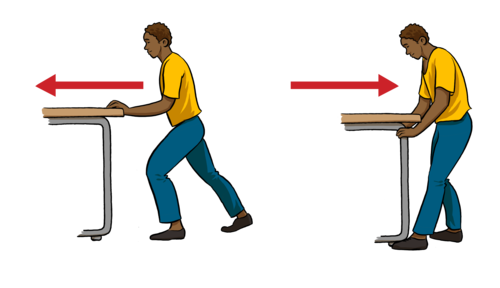
The Newton is defined as the force needed to cause accelerate 1 kilogram of mass at 1 metre per second squared (m/s2).
A force is a push or a pull on an object. The unit in which we measure force is a newton (N). It is named after Sir Isaac Newton, an English physicist and mathematician. Sir Isaac Newton is recognised as one of the most influential scientists of all times. The unit of force is named after him in recognition of his work in mechanics and his three laws of motion.

Have you noticed that one of theDid you know margin boxes in these workbooks contains a drawing of Newton?
In 1687, Newton published Philosophæ Naturalis Principia Mathematica, which is often thought of as one of the most important books in the history of science. In it he describes universal gravitation and the three laws of motion.
We use forces every day of our lives. Our own bodies rely on forces. Our muscles pull on our bones to allow us to move. Our feet push on the ground when we walk. To open doors, to pick up our food - everything we do involves some kind of force.
What can forces do? Let's experiment with forces and see what we can do.
What can forces do?
This activity is all about experimenting with different objects and seeing what happens to them when we push and pull them. Learners should see that pushing on solid objects accelerates them. Pushing or pulling on sponges, balloons and play dough distorts their shape and the ball can be made to move. Each group will need the materials listed below.
MATERIALS:
- blocks (wooden or metal)
- sponge or piece of foam
- ball
- blown up balloon
- putty or play dough
INSTRUCTIONS:
Start with the ball and place it on the ground. Push it towards your partner. What were you able to cause the ball to do by pushing it?
Learners are able to cause the ball to move.
When one of you pushes the ball to the other, the third person must give the ball another push at an angle to the direction in which it is already moving. What were you able to do to the direction in which the ball was moving?
Pushing the ball changes its direction as it is moving.
Exert a force in the opposite direction to its movement while it is already moving. What are you able to cause the ball to do?
Learners are able to slow the ball down or stop it.
Exert a force in the same direction to its movement while it is already moving. What are you able to cause the ball to do?
Learners are able to make the ball move faster.
Pick up the piece of putty or play dough. Exert pulling or pushing forces on it. Try this out with the blown up balloon too. What are you doing to the shape of the putty or play dough and the blown up balloon?
Exerting forces on the putty or playdough changes its shape and it remains deformed. Exerting forces on the balloon also changes its shape, but it resumes its shape again once you stop exerting a force on it.
Push and pull the wooden blocks. Are you able to change their motion? Are you able to change their shape?
Yes, you can change their motion by causing them to move. No, you are not able to change the shape.
Effects of forces
From the last activity, you should have seen that forces can have the following effects:
-
Forces can change the shape of an object. This is called deformation.
-
Forces can change the motion of an object. If an object is stationary, a force can cause the object to start moving. Or, if an object is already moving, a force can cause an object to speed up or slow down.
-
Forces can change the direction in which an object is moving.
How do we describe the motion of an object? When an object is moving, we say it has a velocity. Velocity is the rate of change of the position of an object. Velocity is the speed of an object and the direction in which it is moving. Speed describes only how fast an object is moving, whereas velocity gives both how fast and in what direction the object is moving.
An object can move at constant velocity. This means it travels at the same speed in the same direction. For example a car travelling along the highway at 100 km/h in a straight line has a constant velocity. However, what happens when the car moves faster or slows down?
We saw in the last activity that we could change the motion of an object by applying a force to make it speed up or slow down. The velocity of the object is changing over time due to a force acting on it. This is called acceleration. Acceleration is the rate of change of a body's velocity with time. In other words, it is a measure of how an object's speed changes every second.
Is it a push or a pull?
INSTRUCTIONS:
- Look at the pictures in the table.
- Describe the action in each image.
- Decide if the force being exerted is a push or a pull.
- Describe the effect of the force.
|
Action |
Push or pull? |
Effect |
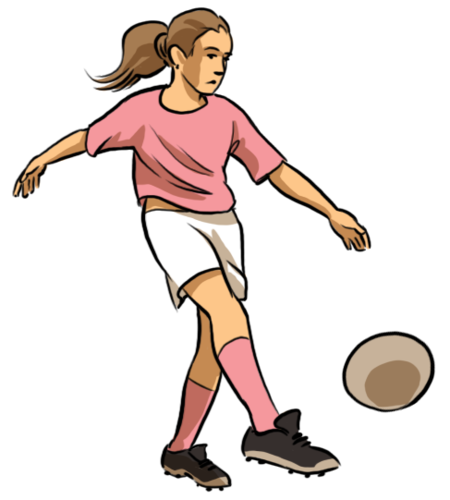 Kicking a ball. |
||
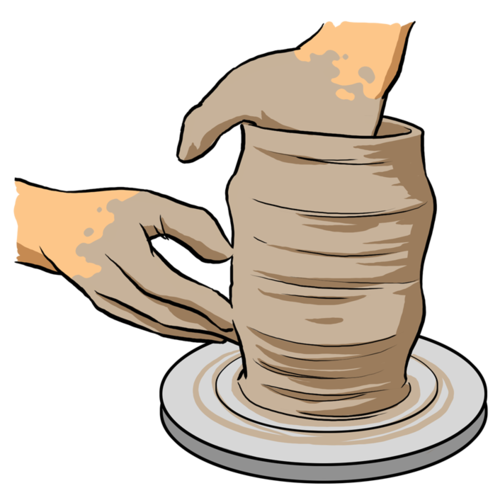 Moulding clay. |
||
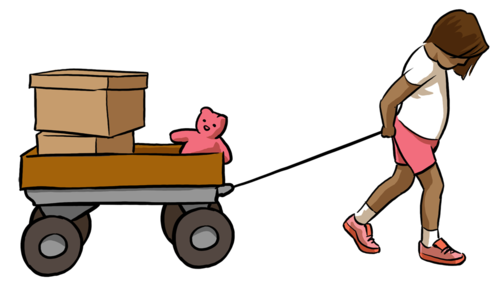 Playing with a toy wagon. |
||
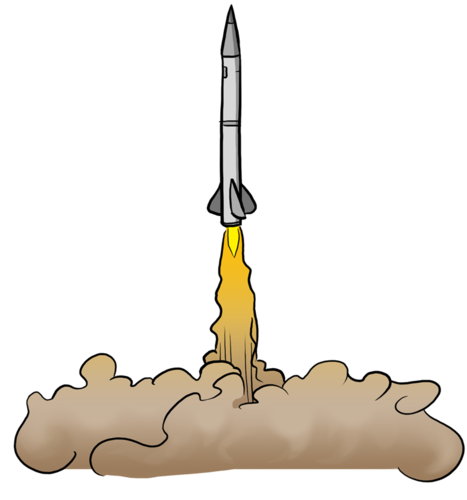 A rocket blasting off into space. |
||
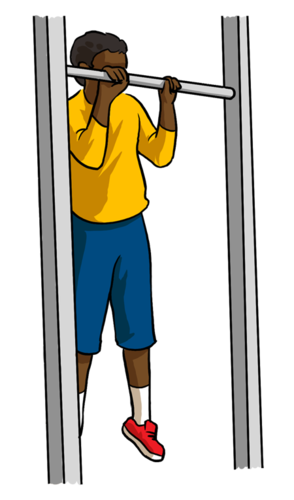 Exercising on a bar. |
|
Action |
Push or pull? |
Effect |
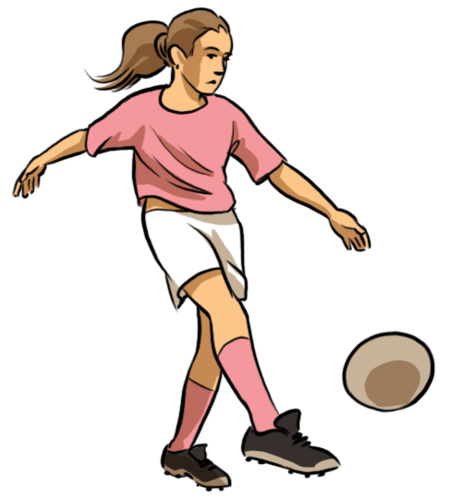 Kicking a ball. |
Push |
Kicking the ball causes the direction and speed of the ball to change. |
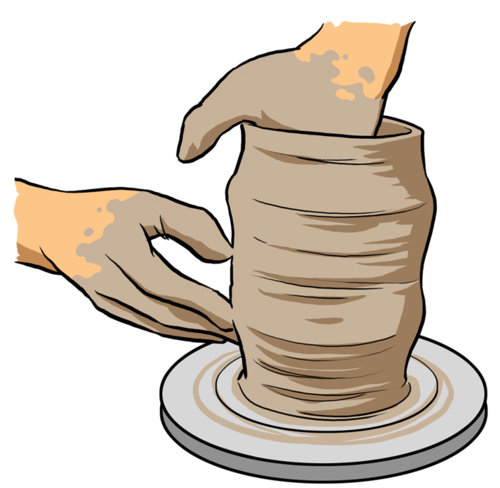 Moulding clay. |
Push |
The push exerted on the clay changes the shape of the clay. |
 Playing with a toy wagon. |
Pull |
Pulling changes the motion of the wagon. |
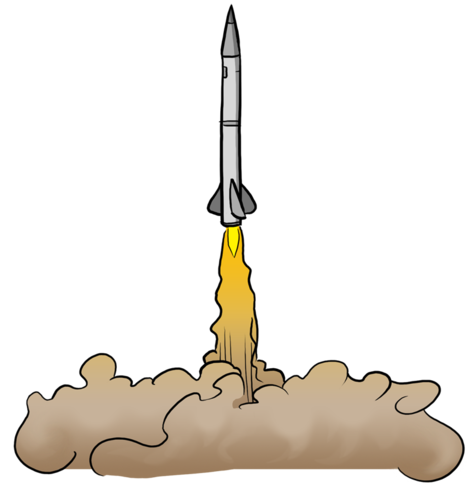 A rocket blasting off into space. |
Push |
Pushing force changes the motion of the rocket (i.e. accelerating it) |
 Exercising on a bar. |
Pull |
Pulling upwards changes the motion of the boy's body. |
QUESTIONS:
These questions on identifying the object experiencing the force and the agent causing the force are conceptually important when applying Newton's laws in later grades.
In the example of the girl kicking the ball, which is the object experiencing the force and which is the agent of the force (i.e. the body which is applying the force)?
The soccer ball is experiencing the force and the girl's foot is the agent applying the force.
When moulding clay, which object is experiencing the force and which object is the agent?
The clay is experiencing the force and the hands are the agent.
Pairs of forces
We are now going to do another practical activity to investigate another concept about forces.
Pairs of forces
INSTRUCTIONS:
Work in groups of three for this activity.
First, go up to your classroom wall and push against it. Describe what you feel below.
Learner-dependent answer. Learners may note that they feel the wall pushing back on their hands.
When you push on the wall, do you think the wall is pushing back on your hands? How does this force compare to the force you are exerting on the wall?
Yes, it is pushing back.
The force experienced by the learners is equal in magnitude and opposite in direction, which will be discussed later.
Stand in a triangle with your two partners and hold hands. Pull on each others' hands. Do you feel your partners' hands pulling back as you pull?
Yes.
Still standing in a triangle, place your palms up against each other and push against each others' hands. Do you feel your partners' hands pushing back as you push?
Yes
Next, stand shoulder-to-shoulder with your two partners. The two learners on the outside must push against the shoulders of the learner in the middle.
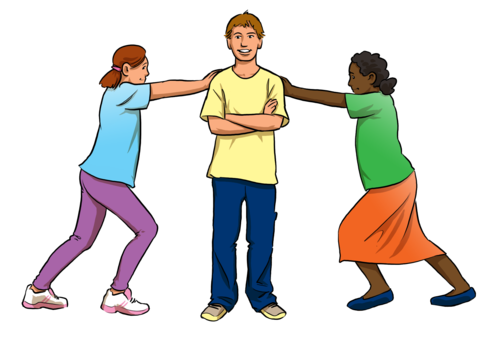
What happens when you both push with the same force?
The learner in the middle remains stationary.
What happens when one of you pushes with a harder force than the other?
The middle learner will move in the direction of the stronger force.
Next, the learner in the middle must stretch out his or her arms. The learners on the outside must pull on the middle learner's hands in opposite directions.
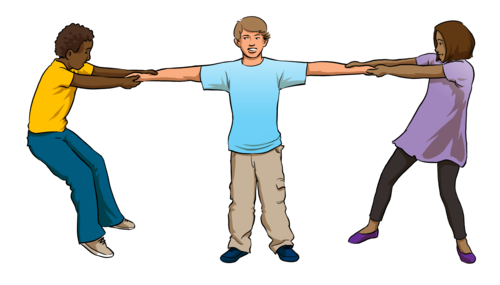
What happens when you both pull with equal force?
The middle learner remains stationary.
This is important for later. It is important to identify the forces on a specific object
What happens when one of you pulls with a stronger force than the other?
The middle learner will move in the direction of the stronger force.
What happens when one of you pulls and the other pushes?
These forces are both acting in the same direction and so the learner moves in the direction of the push and pull.
What we saw in the last activity is that whenever one object exerts a force on a second object, the second object exerts a force back on the first object. You saw this when you pushed against a wall. We say that forces act in pairs. Newton called the one force the action, and the other force the reaction, as shown in the following diagram.
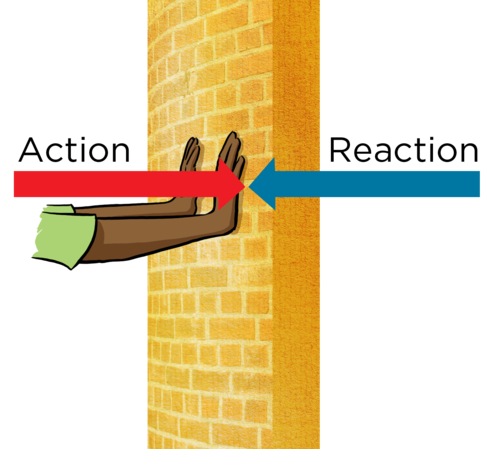
We also saw that when you exerted a force on the wall, you experienced the wall exerting a force back on you. Forces act in pairs on different objects. The force exerted by the second object is equal in strength and opposite in direction to the first force.
What we have described here is actually Newton's Third Law of Motion. The law states that when one body exerts a force on a second body, the second body simultaneously exerts a force equal in strength and opposite in direction to that of the first body.
If you take Physical Sciences in Gr. 10-12, you will study Newton's laws in more detail in Gr. 11. You will see how these three laws laid the foundation for classical mechanics, one of the oldest and largest subjects in science, engineering and technology.
In the last activity, we also saw that more than one force can act on an object at the same time. For example, when two of you were pushing or pulling on your friend in the middle. The effect of the different forces acting together depends on how big each force is and what direction each force is acting in. When two or more forces act on an object, then the forces combine to make a net (overall) force.
What happened when both of you pushed or pulled with an equal force?
Nothing happened as the learner remained stationary.
When the forces are equal to each other and opposite in direction, they balance each other and we say that the net force is 0 N.
What happened when one of you pushed or pulled harder than the other person?
The learner in the middle moved in the direction of the bigger force.
When the forces are acting in opposite directions, but are not equal, we say that the net force is greater than 0 N. There is a resultant force. If the forces are equal and acting in the same direction there will also be a resultant force.
Imagine a tug-of-war. People on either side pull on the rope. If they exert forces of equal size then the rope remains stationary. If one group is able to exert a larger force than the other group, then the rope will move in the direction of the larger force. This is because the forces are unbalanced and there is a net (resultant) force acting in the direction of the larger force.
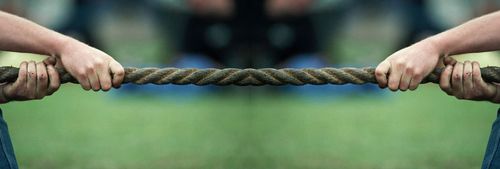
If you have a rope you can get the learners to have a tug-of-war outside on the school field. You can have the children on one side pull while the other side remains idle. Then have both sides pull at the same time. This would be a good way to have the learners feel the effects of the forces on their own bodies.
You also saw that one of you could pull and the other could push in the same direction. In this case, there was a much larger net force as both forces were acting in the same direction and so they add together to produce a bigger overall net force.
We can work out the net forces acting on a body. To do this, we first need to speak about how we represent the forces acting on a body.
Representing forces
How do we show a force? When we want to draw a diagram to show what forces are acting, we use arrows to represent the forces. We always show forces acting from the centre of the object on which it acts. If we were to draw the force on a ball when it is pushed, it could look like this:
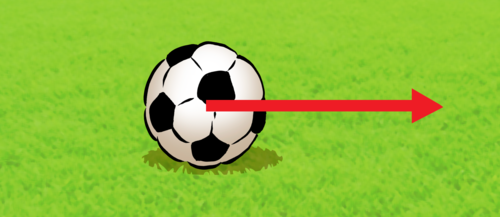
The direction of the arrow shows the direction in which the force is acting, and the length of the arrow is an indication of the size of the force. A small force would be shown with a short arrow. A large force would be shown with a long arrow.
More than one force can act on an object at the same time. The effect of the different forces acting together depends on how big each force is and what direction each force is acting in.
Let's look at how we can represent the following situation: Jabu pulls Rod's arm with a force of 10 N, while Viantha pulls Rod's other arm with a force of 6 N.
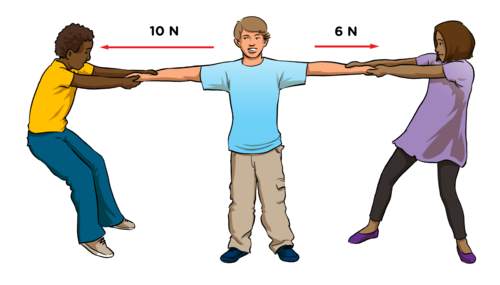
We can represent the forces acting on Rod in the following way: we use a circle to represent Rod and different length arrows to represent the forces acting on him. This is called a free-body diagram.

What is the net force acting on Rod? We can calculate it as follows:
net force = 10 N + (- 6 N) = 4 N to the left.
The force exerted by Viantha is given a negative value as it is in the opposite direction to the force exerted by Jabu.
If the forces all act in the same direction then the net force is the sum of the different forces.
Imagine you are pushing someone in a go-cart, and your friend comes to help you push harder. There are now two forces acting on the person in the go-cart. These forces are acting in the same direction so they are added together to produce a net force which is the sum of the two smaller forces.
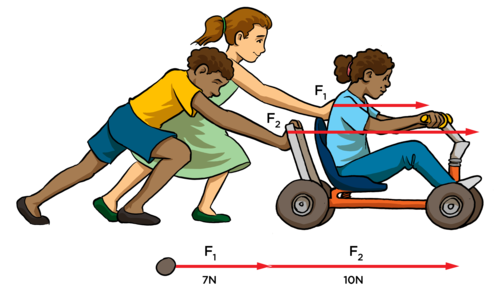
As we will see later on, there are also other forces acting on this system such as friction and weight.
Discover more online as you interact with this simulation on forces and motion. http://phet.colorado.edu/en/simulation/forces-and-motion-basics
This is an optional activity which you can do with learners if you have internet access to run the PhET simulations.
Activity: Tug of war
MATERIALS:
-
PhET simulation: Forces and Motion: Basic http://phet.colorado.edu/en/simulation/forces-and-motion-basics
It would be a good idea to familiarise yourself with the simulation before allowing the learners to use it. This will ensure that you can help them if they encounter problems with the simulation. When using the programme, it is important that learners stop the simulation each time before adding another force. This link is a pdf download with helpful hints on how to use the simulation: http://phet.colorado.edu/files/teachers-guide/forces-and-motion-basics-guide.pdf
INSTRUCTIONS:
- Open the webpage. Click on the button marked "Run".
- Tick all the boxes in the top right corner.
- Place the blue and red team in such a way that the forces are balanced.
- Draw a free body diagram to show the forces acting on the cart. Show the net force (sum of the forces)
Note: The diagram will be learner dependent. They will have chosen a particular combination of blue and red team members in order to achieve a balanced set of forces. Encourage them to play around with the simulation rather than just choosing the first answer they find. Show them that there are many correct combinations. The diagram they draw should have two arrows of the same length facing in opposite directions and the net force should be equal to zero. Remember never to draw the net force. The simulation will show them the correct answer.
- Reset the simulation.
- Place the blue and red team members in such a way as to create an unbalanced force.
- Draw a free body diagram to show the forces acting on the cart.
Note: The vector diagram will be learner dependent. They will have chosen a particular combination of blue and red team members in order to achieve an unbalanced set of forces. Encourage them to play around with the simulation rather than just choosing the first answer they find. Show them that there are many correct combinations. The diagram they draw should have two arrows of different lengths facing in opposite directions The simulation will show them the correct answer.
Point out to learners that unbalanced forces result in a change in motion (acceleration) of a body. In the case of the cart, the unbalanced forces are acting in opposite directions and combine by subtraction. But unbalanced forces can also act in the same direction, for example, if two people are pushing the cart with different forces causing it to accelerate forward, the unbalanced forces combine by addition, as opposed to subtraction.
How do we measure a force? We use an instrument called a spring balance. A spring balance is a simple device consisting of a spring which, when stretched, gives a reading of the force used to stretch the spring.

The functioning of a spring balance is dependent on Hooke's Law which states that when a force stretches or compresses a spring, the distance that the spring moves from its rest position is directly proportional to the size of the force.
Learn more about Hooke's Law and how springs stretch depending on the mass with this simulation. http://phet.colorado.edu/en/simulation/mass-spring-lab
Types of forces
So far, we have looked at forces acting on an object when the object causing the force is in contact with object experiencing the force. Do we always have to be in contact with an object in order to exert a force?
Can forces act over a distance?
This is a short, optional activity to introduce the idea of different types of forces. It can be done as a brief demonstration in front of the class to save time.
MATERIALS:
- bar magnets
- metal paper clips
INSTRUCTIONS:
Bring the north end of another bar magnet close to the south end of the first bar magnet. What happens?
The bar magnets move towards each other
Bring the north end of one bar magnet close to the north end of the other bar magnet. What happens?
The magnets try to push each other away.
Bring a bar magnet over the paper clips. What do you observe?
The paper clips are attracted to the bar magnet.
QUESTIONS:
Did you have to touch the bar magnets together before they would attract each other?
No.
Did the paper clips move towards the magnet?
Yes
What caused the movements?
The magnet exerted a force on the other magnet or the paper clips.
There were forces exerted by the magnets but they did not have to touch each other. That means that you do not have to be in contact with something in order to exert a force on it.
There are two types of forces:
-
Contact forces: objects are in contact with each other and exert forces on each other.
-
Non-contact (field) forces: objects are not in contact with each other and exert forces on each other.
We are now going to look at these two broad groups of forces in more detail.
Contact forces
- friction
- normal force
- tension
- compression
Contact forces are forces between objects which are touching each other. Most of the forces that we looked at in the previous section were contact forces, for example, when you push a desk, or pull a go-cart. You are touching the object.
Friction
What happens when you kick a ball across the grass? The ball moves quickly at first but then slows down again. Something has caused the ball to slow and stop moving. If the motion of the ball has changed then a force must have been exerted on it. The force which opposes motion is called friction. Friction forces always act in the opposite direction to the motion of the object. Friction resists movement when the object and surface are in contact. What does that mean? It means that if the ball is moving forward then friction acts backwards on the ball.
The following image shows a ball which has just been kicked. Draw an arrow to show in which direction friction would be acting.
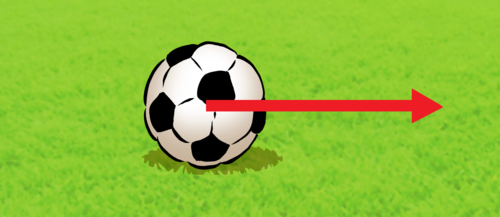
Learners must draw the arrow in the opposite direction to the red arrow.
What factors will affect the amount of force required to move objects? We need to look at all the forces acting on an object. Do you remember the following diagram from the beginning of the chapter?
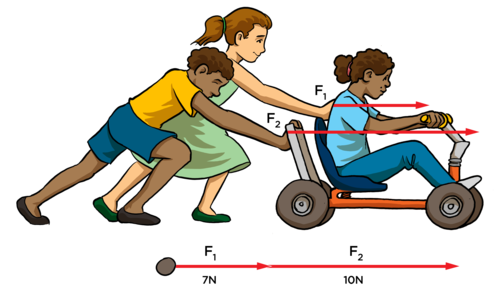
We only showed the forces of the two learners pushing on the go-cart. What other forces are acting on this go-cart as it moves along?
Friction is acting on the go-cart in the opposite direction to the motion of the go-cart. The go-cart also has a weight. As we learnt in Gr. 8 Planet Earth and Beyond, an object on earth has weight due to the gravitational force of attraction of the Earth on the object. This is a force acting on an object.
We will learn more about weight and the gravitational force in the next section.
We can now draw the friction and weight in the free-body diagram of the forces acting on the go-cart as follows.
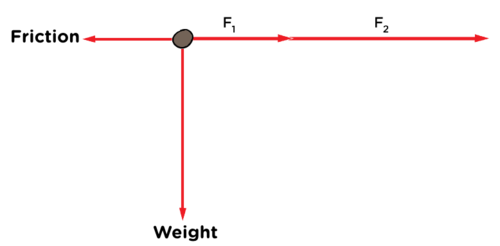
There is another force acting on the go-cart. Think of when you stand on the ground: you feel the ground beneath your feet. This contact force is preventing you from penetrating the ground. This is called the normal force. The normal force always acts perpendicularly to the surface that the object is resting on.
In simple situations such as when you are standing on the ground or the go-cart is travelling along a level surface, then the normal force is equal to the weight of the object, but in the opposite direction. Think back to what we learnt about forces acting in pairs. On a flat, level surface, the normal force is the reaction force to the weight of the object. This is shown in the diagram for a box resting on the floor.
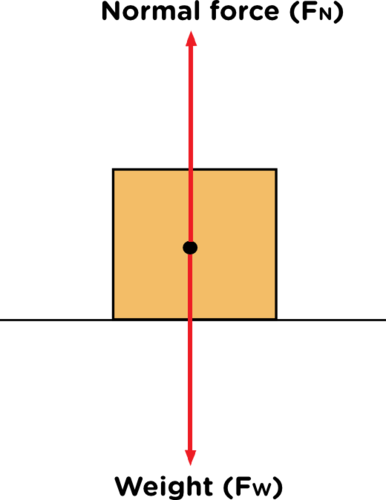
We can now complete the free-body diagram of the forces acting on the go-cart as follows,
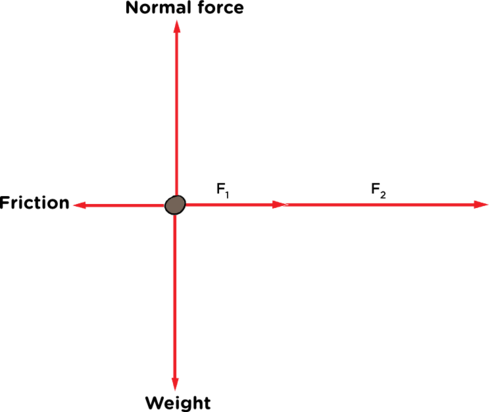
Do you think there is a relationship between the friction that a body experiences and the normal force? Let's investigate.
Explore the forces at work when you try to push a filing cabinet in this simulation. http://phet.colorado.edu/en/simulation/forces-and-motion
What is the relationship between the normal force and friction?
This investigation will show the students that the frictional force is related to the normal force. The normal force is the reaction of the surface to the weight of an object.
As long as you have a scale you can use any objects as mass pieces. The learners will need to use the spring balances to measure the forces that they exert on the blocks. It is important that they measure the force as the block starts moving, because the reading will drop once the block is moving since kinetic friction is less than static friction.
Learners have already been introduced to weight in previous grades and will cover it in more detail in the next section where they will actually calculate gravitational acceleration for themselves. For now, just use the value of g = 9,8 m/s2 and then you can refer back to this investigation when learners work out gravitational acceleration for themselves later on.
INVESTIGATIVE QUESTION: What is the relationship between the normal force and friction?
AIM: To determine the relationship between the normal force and the size of the frictional force.
In the situations that we are going to investigate, the object will be pulled along on a flat, level surface. We will increase its mass and measure the resulting frictional force. But how does this relate to the normal force?
Where the object is on a flat level surface, the normal force is equal to the weight. As you learnt in Gr. 8 Planet Earth and Beyond, and will see in the next section, we can calculate the weight of an object. We can therefore calculate the normal force acting on the object.
For this investigation, calculate the weight using the formula W = m × g, where m is the mass of the object in kg and g is 9,8 m/s2. We will learn more about this in the next section.
MATERIALS AND APPARATUS:
- wooden blocks with different known masses or mass pieces
- wooden block with a hook
- spring balance
- triple beam balance or electronic scale
Any mass measuring device would be suitable for this investigation.
METHOD:
- Measure the mass of the wooden block with a hook with the triple beam balance. Record the mass in the table. Calculate and record the normal force.
- Put the wooden block with the hook on the table. Attach the spring balance to the hook. Make a small mark on the desk from which to start pulling the block.
- Pull sideways to the point that the block just starts moving.
- Record the force reading in the table below. Repeat this three times for the wooden block.
-
Put a mass piece on top of the wooden block. Record the total mass. Calculate and record the normal force. Pull it sideways to the point that it starts to move. Record the force. Repeat this three times. In each case, start the block from the same position and pull gently.
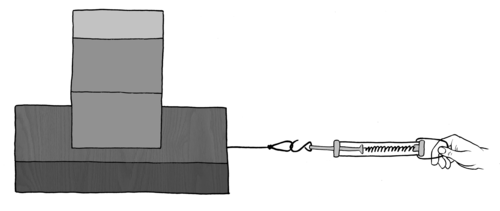
- Repeat the experiment for larger masses and complete the table.
We are measuring the static friction, which is the friction between two objects that are NOT moving. We measure it as the minimum force required to start the block moving.
RESULTS:
The results obtained will depend on the mass of blocks used and the surface on which the investigation is carried out. It is important that the learners see that as the mass increases, the normal force increases and the the reading on the spring balance, measured as the block begins to move, also increases.
Table to record the force required to overcome the frictional force and move the block.
|
Mass (kg) |
Normal force (N) |
Reading 1 (N) |
Reading 2 (N) |
Reading 3 (N) |
Average (N) |
We take three readings and then calculate an average. This increases the reliability of the results.
Plot a graph of the average force applied to the block at rest against the normal force of the block.
The force applied to the point at which the block starts to move is equal to the frictional force acting on the block.
Which is the dependent variable?
The size of the frictional force.
Which is the independent variable?
The normal force as a result of the mass of the blocks.
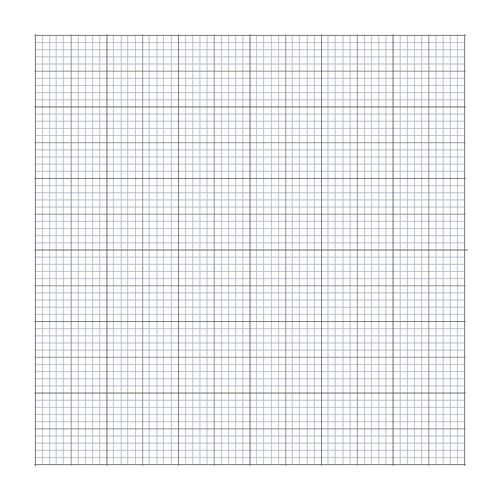
ANALYSIS:
Draw a labelled free-body diagram of all the forces acting on the block just as it is about to start moving.
An example free-body diagram. The weight and normal force must have arrows of equal size. The pulling force must be equal in size to the friction as the diagram represents that object just as it is about to start moving.
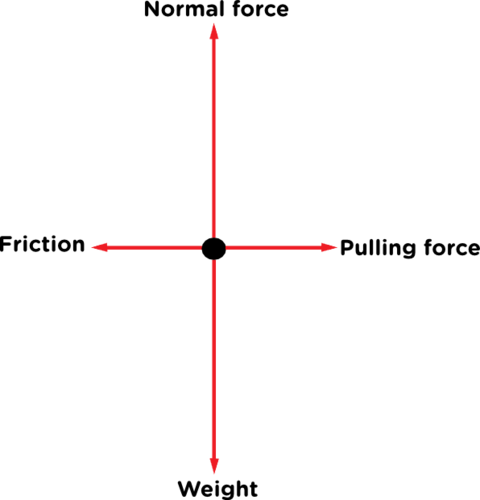
Why is the weight on the block being changed when the aim of the investigation is to find out how the normal force affects frictional force?
The object is on a flat surface so the normal force equals the weight. Increasing the mass, increases the weight as W = m × g, therefore the normal force increases.
Why are three readings taken for each setup and an average calculated?
Repeating the experiment increases the reliability of the results.
What is the shape of your graph?
The shape should be a straight line through the origin. The actual shape will depend on the accuracy of the learners' results and plotting. It is only important that the graph shows an increasing trend so that the relationship between the normal force and friction can be established.
What does the shape of the graph tell us about the relationship between the normal force of the block and the friction force?
The shape tells us that as the normal force increases,` so does the size of the friction force.
What do you think would happen if the block was not placed on the smooth desk, but rather on a rough surface, or a much smoother surface? Will this affect the results?
Yes, this will affect the result as the frictional force between different kinds of surfaces is different, for example between smooth and rough surfaces.
CONCLUSION:
Write a conclusion for this investigation.
The friction force increases as the normal force of the object increases.
Repeat the investigation and take some readings from the spring balance once the block is moving. How do the readings for the stationary block and a moving block compare? Is there a difference?
When the block is moving at constant speed, the friction decreases, compared to the friction that has to be overcome to make the block move.
Static friction is the maximum friction reading just as the block starts to move. Then, when the block is moving at a constant speed, the friction decreases and is called moving friction. In the first part of the investigation, we only measured the average static friction with different masses. This extension will show learners that once the object starts to move, the friction decreases.
This is an optional activity which you can do with learners if you have internet access to run the PhET simulations.
Activity: Friction
MATERIALS:
-
PhET simulation: Forces and Motion: Basic http://phet.colorado.edu/en/simulation/forces-and-motion-basics
Note: It would be a good idea for you to familiarise yourself with the simulation before allowing the learners to use it. This will ensure that you can help them if they encounter problems with the simulation. This link is a pdf download with helpful hints on how to use the simulation: http://phet.colorado.edu/files/teachers-guide/forces-and-motion-basics-guide.pdf
INSTRUCTIONS:
- Open the webpage. Click on the button marked "Run".
- Choose the tab labelled "Friction".
- Tick all the boxes in the top right corner.
- Choose one of the crates from the selection box and drag it next to the man.
- Exert a force on the crate. Slowly increase the amount of force exerted until the crate begins to move.
QUESTIONS:
- Before the object starts moving, what do you notice about the size of the friction force compared to the size of the applied force? Are they balanced or unbalanced?
The forces are unbalanced. The friction force is greater than the applied force.
- After the object starts moving, what do you notice about the size of the friction force compared to the size of the applied force? Are they balanced or unbalanced?
The forces are unbalanced. The applied force is greater than the friction force.
- What have you learnt about getting an object to move?
There needs to be an unbalanced force in order for the object to move. The applied force needs to be greater than the friction force.
The force of friction depends on the type of surface on which an object is moving and the normal force. In order to get an object to move, a force greater than the frictional force needs to be applied in order to overcome the friction between the object and the surface.
We can now look at the example of pushing a friend in a go-cart again. There is friction between the go-cart and the ground. The friction acts in the opposite direction to the forces pushing the go-cart forward. Therefore, if there are two forces of 7N and 10N pushing the go-cart forward, and the friction is 5 N, we can show only these forces as follows:

What is the net force acting on the go-cart?
12 N to the right.
Friction between two surfaces also causes the objects to heat up. Try this out by rubbing your hands vigorously together and then feel your palms afterwards.
Friction is advantageous for a number of reasons. For example, the friction between our feet and the ground enables us to move forward and prevents us from slipping. Friction is also involved in keeping cars from skidding as the tyres experience friction between the tread and the roadway.
Learn more about how friction causes a material to heat up and melt. Rub two objects together and they heat up. When one reaches the melting temperature, particles break free as the material melts away. http://phet.colorado.edu/en/simulation/friction
Tension and compression
In order to introduce these forces, a suggestion is to bring different objects to class to experiment with. An ideal object is a piece of foam as you can then show tension and compression by pulling and pushing it, respectively, and also bending it.
There are other forces which are contact forces. Look at the following drawing of a boy pulling on a block with a rope.
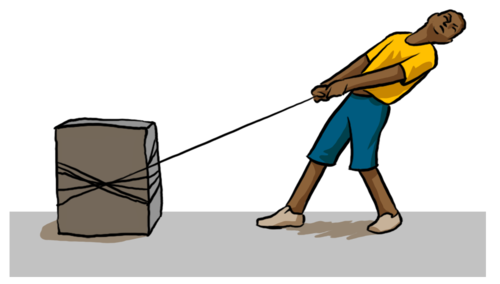
The person is pulling the rope which is pulling the block. The person is not touching the block directly. The person is pulling the rope and the block is pulling back on the rope in the opposite direction. This causes a tension force to exist in the rope. The rope is tight and so there is tension in the rope. Tension is a contact force. The tension in the rope pulls the block across the floor.
Another example of a contact force is compression. A compression force is a force which acts to deform or squash an object. Let's think of some examples.
Provide the class with play dough and have them form balls which they can then compress in their hands as in the picture below.
If you take a ball of dough and crush it with your fingers, you are exerting a compression force on the dough. The dough changes shape. It deforms. Another example is crushing a tennis ball or a cooldrink can between the palms of your hands.
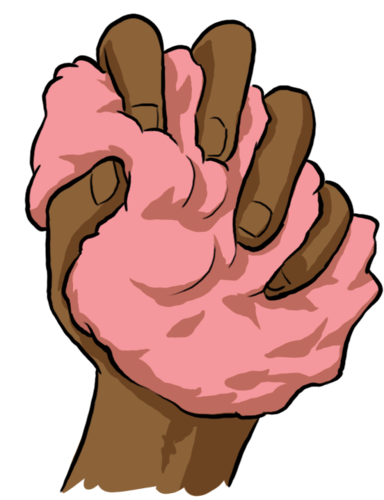
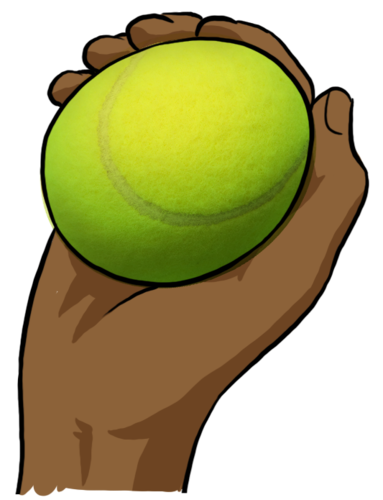
The following diagram summarises the difference between tension and compression.
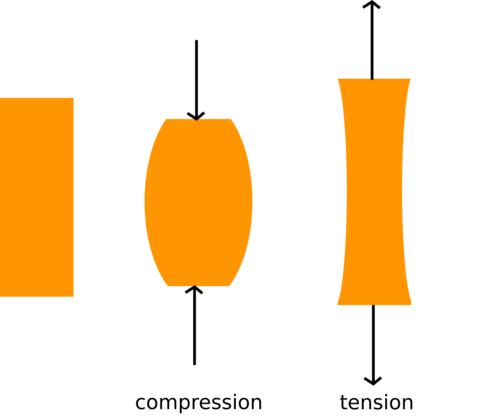
There are many other examples of compression forces in everyday life. A bridge experiences both compression and tension due to the weight of the cars and other vehicles which pass over it as shown in the following diagram.
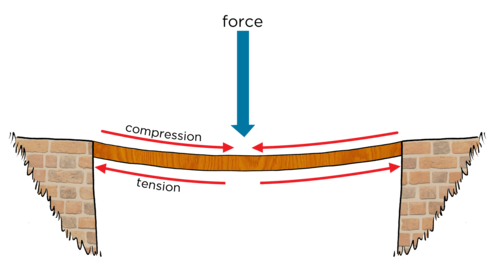
We have been looking at contact forces, which include friction, normal forces, compression and tension. We are now going to look at the forces that act between bodies which do not touch.
Field (non-contact) forces
- gravitational force
- magnetic force
- electrostatic force
- field forces
- attraction
- repulsion
A field is a region in space where an object (with certain properties) will experience a force. Field forces are non-contact forces. Non-contact forces are forces which act over a distance. They do not have to be touching. The most common examples of fields are:
- gravitational field
- magnetic field
- electric field
When we discussed contact forces, we spoke about pushes and pulls. However, with field forces, it is better to talk about repulsion and attraction.
Gravitational forces
Have you ever wondered why things fall down and not up?
You can demonstrate the gravitational effect by dropping objects of different masses from an equal height. Use a tennis ball and a balled-up piece of paper (so that they are approx. the same size and shape). Drop them from the same height and see if the learners can see a difference in the way that they fall. Ask the learners why they think the objects fell. Is something pushing them down? Or pulling them down? Get them to discuss their ideas with each other.
The simulations provided in this chapter are very worthwhile looking at if you have internet access. Otherwise, encourage learners to interact with them in their own time at home or on their mobile phones.
We have already come across gravity in Planet Earth and Beyond in previous grades.
The force which causes things to fall down towards the Earth and prevents us from falling off the planet is the gravitational force. Gravitational forces exist between any two objects with mass and they are forces of attraction (pull).
Newton developed his Law of Universal Gravitation, describing the force of attraction between bodies with mass in 1687. Newton's work on describing a theory of gravitation may have been inspired by watching an apple fall from a tree.
Strictly speaking, when talking about "gravity" we are specifically referring to the gravitational force of attraction that occurs between the Earth (or another celestial body like a planet) and other objects, as opposed to the gravitational force in general which acts between any two objects with mass. For example, we would refer to the gravitational force acting to attract objects to the Moon as the gravitational force due to the Moon.
What is gravity?
The gravitational force is a force that attracts objects with mass towards each other. Any object with mass exerts a gravitational force on any other object with mass. The Earth exerts a gravitational pull on you, the desks in your classroom and the chairs in your classroom, holding you on the surface and stopping you from drifting off into space.
Gravity is a force and is therefore measured in Newtons.
The Earth's gravitational force pulls everything down towards the centre of the Earth which is why when you drop an object like a book or an apple, it falls to the ground. However, do you know that you, your desk, your chair, and the falling apple and book exert an equal but opposite pull on the Earth? Why do you think these forces on the Earth do not cause the Earth to move noticeably?
The Earth has a much larger mass than a person or a desk and so it is accelerated by a much smaller amount even though the force exerted on the Earth by a desk is the same size as the force exerted on the desk by the Earth (just in opposite directions). This is why the Earth does not move noticeably.
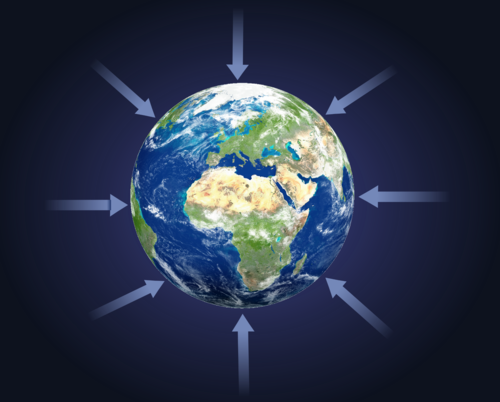
Interact with this simulation to see the relationship between gravity and the masses of the objects and distance between them. http://phet.colorado.edu/en/simulation/gravity-force-lab http://phet.colorado.edu/sims/html/gravity-force-lab/latest/gravity-force-lab_en.html
The PhET simulation in the visit box can be used to demonstrate very easily how the gravitational force between two objects increases with mass and decreases as the distance between the objects increases. You can turn off the values, and use the position of the little figures tugging on the ropes to demonstrate the relationships qualitatively.
The Earth attracts us because it has such a large mass and so we are attracted downwards towards the centre of the Earth all the time.
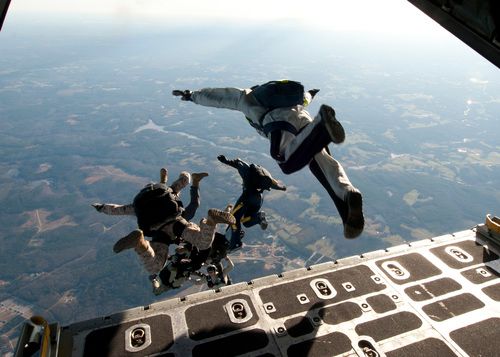
The bigger the mass of the objects, the greater the force between them. This means that two small objects would have a very weak gravitational attraction and so it has no noticeable effect. However, bigger objects such as the Moon and the Earth have a much greater gravitational force.
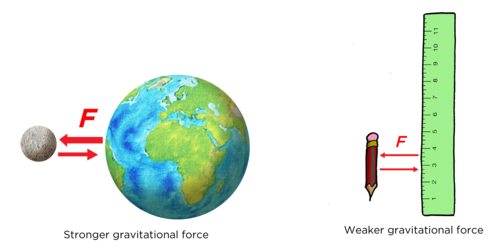
Move the Sun, Earth, Moon and space station to see how it affects their gravitational forces and orbital paths. http://phet.colorado.edu/en/simulation/gravity-and-orbits
As we know from Planet Earth and Beyond, all the planets in our solar system are held in orbit around the Sun by the gravitational force of attraction between the Sun and planets.
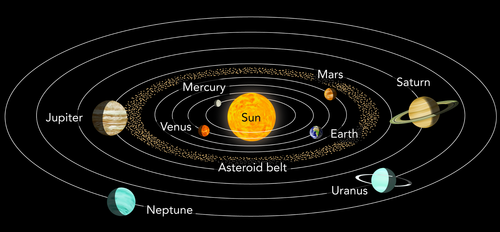
Build your own solar system with this simulation and experiment with the masses and orbits. http://phet.colorado.edu/en/simulation/my-solar-system
The second factor which affects the gravitational force of attraction between objects is the distance between them. The further objects are away from each other, the smaller the gravitational force.
There is a gravitational force of attraction between us and the Sun, but we do not notice it as we are so far apart, and we are very small.
All the components in our Universe are held together by a gravitational force. In summary we can say:
-
The greater the mass of the objects, the stronger the gravitational force of attraction between them.
-
The closer objects are to each other, the stronger the gravitational force between them.
Dropping objects
A note on falling objects
A useful way to demonstrate the Earth's gravity is to look at falling objects. An optional extension activity is included below in which learners drop a variety of objects. You can take a vote from the class to see whether learners think that an apple or bag of sugar would hit the ground first. (Answer: they would hit the ground at the same time as long as air resistance is negligible.) It is very likely that learners will have the preconception that heavier items fall faster. It is not important at the moment that the learners' answers are correct and do not try to lead them to the correct answer. They will hopefully discover it for themselves in the following experiment.
In this investigation learners need to work in pairs. They will initially drop a whole apple and half an apple from the same height at the same time. They will then further experiment with balls of different masses (but the same size) and balls of the same mass (but different volumes). It is very hard to drop objects at exactly the same time so that they hit the floor simultaneously so let the learners repeat the experiment several times until they are confident that they are dropping the objects at the same time. If it is hard for them to see which object hits the ground first, suggest to learners that they listen for the number of sounds they hear - one or two - when the objects hit. Learners might need to repeat this investigation many times since it most likely contradicts their preconceptions. Safety tip: It is probably a good idea to have the apples cut in half ahead of time.
Once the learners have finished their experiment you can demonstrate the effects of air resistance by dropping a hammer and a feather. Have the learners take a vote on what will happen when you drop the hammer and feather. Be ready to explain to learners that air resistance slows the fall of the feather and that if there were no air resistance the two would fall at the same rate and hit the floor at the same time.
INVESTIGATIVE QUESTION: Do different objects fall at the same rate?
HYPOTHESIS:
What do you think will happen?
Learner-dependent answer.
MATERIALS AND APPARATUS:
- hammer
- feather
- two balls of the same mass, different volumes (one set per pair)
- two balls of the same volume, different masses (one set per pair)
Video of feathers and coins falling in a vacuum
METHOD:
- Work in pairs, take turns to be the person who drops an object (experimenter) and the person who observes the objects dropping (observer).
- Complete the "prediction" column in the table below.
- Experimenter: stand on top of a chair or desk and take the two balls of the same mass, with one in one hand and the other in the other hand.
- Experimenter: hold the two balls up at the same height in front of you and drop them at exactly the same time.
- Observer: note what happens, in particular which lands first.
- Swap positions and repeat the experiment using two balls which have the same volume but different masses.
- Your teacher will now do a demonstration for you and drop a hammer and a feather. Before your teacher drops the hammer and feather, record the prediction column for the hammer and feather drop.
- Record what happened with the hammer and feather and answer the questions below.
RESULTS AND OBSERVATIONS:
What did you keep constant in this experiment?
The height at which objects are dropped.
What did you change in this experiment?
The type objects that are being dropped, in particular the mass and volume of the objects.
In the table below, record what you think will happen in the "prediction" column before you conduct your experiment. Assuming that you drop each pair of objects from the same height at the same time, what do you think will happen? Which do you think will land first?
|
Objects |
Prediction |
Observation |
|
Balls: same mass, different volume |
||
|
Balls: different mass, same volume |
||
|
Hammer and feather |
EVALUATION:
How reliable was your experiment? How could you improve your method?
Learner dependent answer. Example answers could include: It is difficult to drop objects at exactly the same time. It would be better to drop the objects from a greater height. Air resistance could have affected the results and it would be better to drop the objects in a vacuum.
CONCLUSIONS:
Write a conclusion for this investigation.
Learners should have found that the half apple and the whole apple hit the floor at the same time. They should also have found that the balls of the same mass hit the floor at the same time and also the balls of the same volume hit the floor at the same time. From this they should conclude that all objects dropped fall at the same rate no matter what their shape or size if air resistance can be ignored. (Advanced: they accelerate at the same rate). In the case of the hammer and feather drop, learners should have found that the hammer landed first. This is because of the effects of air resistance slowing the feather's fall.
Misconceptions about falling objects (video)
QUESTIONS:
Which landed first, the apple or the half apple?
They should have both landed at the same (or close to the same) time.
Considering the balls of the same mass, which landed first, the larger one or the smaller one?
They should have both landed at the same time.
Considering the balls of the same volume, which landed first, the heavier one or the lighter one?
They should have both landed at the same time.
Why do you think the two dropped balls always landed at the same time?
In an ideal situation, all objects dropped from the same height will land at the same time. This is because the Earth's gravitational force causes each object to get faster by the same amount every second, no matter how heavy it is or what its volume is.
Advanced Teacher Note:
According to the Universal Law of Gravitation, the Earth's gravitational force pulls down on an object with a force that is proportional to the mass of the object and the mass of the Earth. In all cases the mass of the Earth is the same and so any differences in the gravitational force on objects on Earth depends only upon the difference in the mass of the objects being dropped.
According to Newton's second law, the net force exerted on an object, F, is given by F=ma where m is the mass of the object and a is the acceleration produced by the net force F.
Why do you think the hammer landed before the feather?
In a real situation, the air around us affects how objects fall. As an object moves through the air, and experiences air resistance. The feather is much lighter than the hammer and so the effect of air resistance is much larger on the feather. The net force acting downwards on a falling object is the gravitational force minus force due to air resistance. As the feather is much lighter than the hammer, the net force acting on it will be less and so it will experience a smaller acceleration towards the ground and fall more slowly.
Advanced Teacher Note:
Air resistance is a drag force acting to slow the object down. The size of the force depends upon the velocity of the falling object squared, the surface area of the falling object, and the density of the fluid it is falling in (in this case air). Very light objects are slowed by air resistance, like feathers or thin sheets of paper. This is because their gravitational force is very small compared to the air resistance. Very large objects are also slowed by air resistance. This explains why a parachute slows your fall. Before you open a parachute air resistance is small. After opening, the wide parachute experiences greater air resistance which then slows you down.
It is very important that learners understand the difference between mass and weight. In science, weight is a force, but learners are used to using the word "weight" when describing their mass. Weight is the force experienced by an object due to gravity. On Earth, all objects are attracted downwards towards the centre of the Earth and our weight is an indication of the size of that attraction. Weight will vary depending on our position in space but our mass should remain constant regardless of our position.
You have probably heard the term 'weight' used many times before, either in your Natural Sciences classroom, or in conversation with others. Many people use the term weight incorrectly in everyday language. For example, a relative may say to you "My weight increased by 2 kgs over the holiday period as I ate too much food." What is wrong with this statement? Discuss this with your class and teacher.
This statement is incorrect as the relative is equating her/his weight with kilograms. Kilograms are a measure of mass, not weight. Her mass might have increased by 2 kilograms.
- weight
- mass
- free-fall
- gravitational acceleration
The word mass comes from the Greek word maza which means a lump of dough or cake.
The mass of an object is the amount of matter in the object. It tells you how many particles you have. Do you remember learning about atoms in Matter and Materials? So, for example, the mass of a wooden block tells us how many atoms there are. Mass is measured in kilograms (kg) and is independent of where you measure it. A wooden block with a mass of 10 kg on Earth also has a mass of 10 kg on the Moon.
However, an object's weight can change as it depends on the mass of the object and also the strength of the gravitational force acting on it. Weight is measured in newtons (N) as it is the gravitational force of attraction exerted on an object by the Earth (or Moon or any other planet). Therefore, the weight of an object will change when weighed in different places. The weight of a 10 kg block on Earth will be different to that on the Moon. Why do you think this is? Will the weight be more or less than on the Moon?
The Earth is much larger than the Moon and so the gravitational force between the Earth and the block will be greater than the force between the Moon and the block.
Mass, weight and gravity (video).
What is the relationship between the mass of an object and its weight?
INVESTIGATIVE QUESTION: What is the relationship between the mass of an object and it's weight?
HYPOTHESIS: Write a hypothesis for this investigation.
Learner-dependent answer.
MATERIALS AND APPARATUS
- four mass pieces in increments of 500g (one of 500g, one of 1kg, one of 1,5 kg and one of 2 kg)
- spring balance
- triple beam balance
Any mass meter can be used to measure the mass of the objects. Kitchen scales or electronic scales can also be used.
METHOD:
- Measure the mass pieces on the triple beam balance.
- Measure the weight of each mass piece with the spring balance.
- Record the mass and matching weight in the results table.
- Draw a graph of your results.
- Calculate the gradient of the graph.
RESULTS:
Record your results in the following table.
|
Mass (kg) |
Weight (N) |
An example of the results if using the suggested mass pieces:
|
Mass (kg) |
Weight (N) |
|
0.5 |
4.8 |
|
1 |
9.8 |
|
1.5 |
14.7 |
|
2 |
19.6 |
What is the dependent variable?
Weight
What is the independent variable?
Mass
Therefore, weight is on y-axis versus mass on the x-axis
Draw your graph in the space provided below.
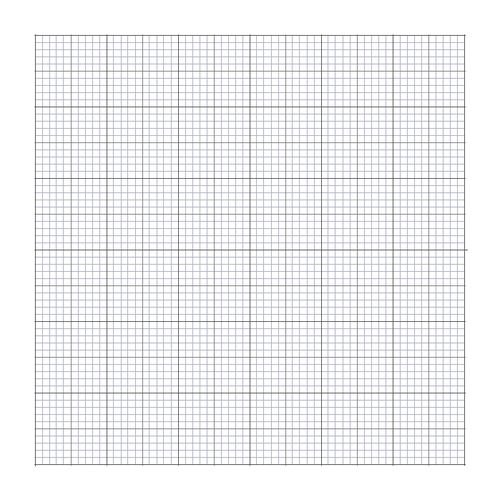
Your graph should be a straight line. Use the space below to calculate the gradient of your graph.
The gradient should be 9,8.
You may need to remind the learners about calculating the gradient of a straight line. They should have covered this topic in Mathematics but it would be useful to remind them. They need to choose two co-ordinates on their straight line. They can choose any two coordinates which should be labelled as (x1 ; y1) and (x2 ; y2). The formula for the gradient of a straight line is gradient = rise/run = (y2 - y1)/(x2 - x1)
Example calculation: gradient = (9,8 - 4,8)/(1 - 0.5) = 9,8
Learners may not get the correct answer for the gradient if they have not plotted correctly or if the spring balances are not calibrated properly. They may get an answer closer to 10. The gradient of the graph gives the gravitational acceleration on Earth. This will be explained in the text after the investigation.
CONCLUSION:
Write a conclusion for this investigation.
The weight of an object is directly proportional to the object's mass.
Weight is the force of gravity pulling you towards the centre of the Earth. It is measured in newtons. On Earth the gravitational force causes us all to accelerate towards the centre of the Earth. The acceleration is called gravitational acceleration. On Earth it is 9,8 m/s2. The gradient that we calculated in the last investigation should have given you a number close to 9,8 m/s2 which is gravitational acceleration.
Objects are in free-fall when the only force acting on them is the gravitational force.
Weight (W) is calculated by multiplying an object's mass (m) by the gravitational acceleration (g):
W = m × g
We used this formula in the last section on friction to calculate the weight and therefore the normal force acting on an object.
But what if you went to the Moon?
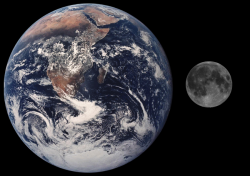
The mass of the Earth is 5.972 × 1024 kg.
The Moon also has its own gravity. The strength of gravity on the surface of the Moon is one-sixth that on the surface of the Earth, and so you would weigh one-sixth of what you do on Earth on the Moon. On Jupiter you would weigh 2.5 times more than you do on Earth as Jupiter's gravity is 2.5 times that of the Earth's. Even though you would weigh different amounts (and feel lighter on the Moon and heavier on Jupiter) your actual mass would stay the same in both cases.
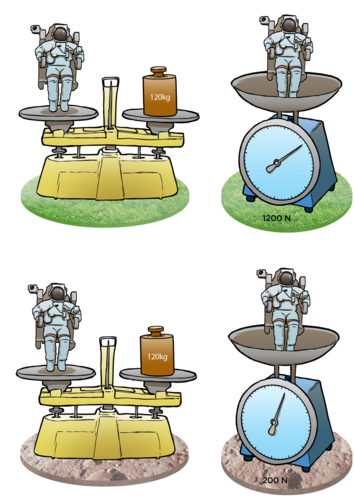
So how much would you weigh on the Moon? Imagine you have a mass of 60 kg. Your weight on Earth would be 60 x 9,8 = 588 N. The gravitational acceleration on the Moon is 1,6 m/s2, so your weight would be 60 x 1,6 = 96 N on the Moon.
A bathroom scale actually measures weight and converts it to mass.
Weight and mass calculations
This is a short activity to practice some calculations. Learners can complete this as a homework task.
QUESTIONS:
A Ferrari has a mass of 1485 kg. What is its weight on Earth?
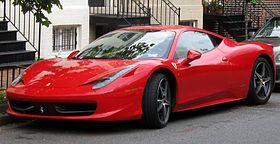
weight = 1485 x 9,8 = 14553N
Lindiwe has a mass of 50 kg on Earth. What is her mass on the Moon?
50 kg as the mass of an object is independent of position.
weight on Moon = 78 X 1,6 = 124,8 N
Sam is incorrect.
mass = 220 g = 0.22 kg.
weight on Earth = 0.22 x 9,8 = 2,156 N
weight on Moon = 0,22 x 1,6 = 0,352 N
If a cow weighed 1340 N on the Moon, what is its mass?
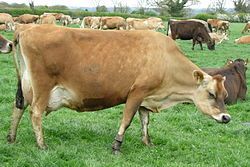
mass = 1340 / 1,6 = 837.5 kg
Discover more online as you interact with this simulation using different mass pieces and springs. Transport the lab to different planets. http://phet.colorado.edu/en/simulation/mass-spring-lab
The PhET simulation listed in the visit link can be used to easily show how the weight of objects change. This simulation can be used at many different levels, depending on the complexity of the concepts that you want to illustrate. A link to a pdf containing teaching tips from the PhET team is available here: http://phet.colorado.edu/files/teachers-guide/mass-spring-lab-guide.pdf
Ever wondered what it would be like to walk around on other planets? Find out how much you would weigh on other planets in the next activity.
How much would you weigh on other planets?
This is an optional activity. In this activity, learners calculate what their weight would be on the seven other planets in our solar system. Although their mass remains the same, they will "feel" lighter or heavier because of the differences in the gravitational field strength on the surfaces of the other planets. You should emphasise that their mass always remains the same, but only their weight varies. If you do not have access to weighing scales you can either ask learners to estimate their mass or provide them with an example number.
MATERIALS:
- weighing scales
- calculator
INSTRUCTIONS:
|
Planet |
Your mass (kg) |
Value of g (m/s2 ) |
Your weight (N) |
|
Earth |
9,8 |
||
|
Mercury |
3,6 |
||
|
Venus |
8,8 |
||
|
Mars |
3,8 |
||
|
Jupiter |
26 |
||
|
Saturn |
11,2 |
||
|
Uranus |
10,5 |
||
|
Neptune |
13,3 |
Example answers for a 50kg learner
|
Planet |
Your mass (kg) |
Value of g (m/s 2 ) |
Your weight (N) |
|
Earth |
50 |
9,8 |
490 |
|
Mercury |
50 |
3,6 |
180 |
|
Venus |
50 |
8,8 |
440 |
|
Mars |
50 |
3,8 |
190 |
|
Jupiter |
50 |
26 |
1300 |
|
Saturn |
50 |
11,2 |
560 |
|
Uranus |
50 |
10,5 |
525 |
|
Neptune |
50 |
13,3 |
665 |
QUESTIONS:
On which planets would you feel heavier than you do on Earth?
You would feel heavier on Jupiter and Neptune.
On which planets would you feel lighter than you do on Earth?
You would feel lighter on Mercury, Venus, Mars, Saturn and Uranus.
The weight of a person is the force of gravitational attraction to the Earth that person experiences. Someone in free-fall feels weightless but they have not lost their weight. They are still experiencing the Earth's gravitational attraction.
The only reason the astronauts float is because they are in free-fall and their moving spacecraft is also in free-fall with them, falling at the same rate. Therefore, the astronauts appear to float when compared with the spacecraft because they are both falling at the same rate.
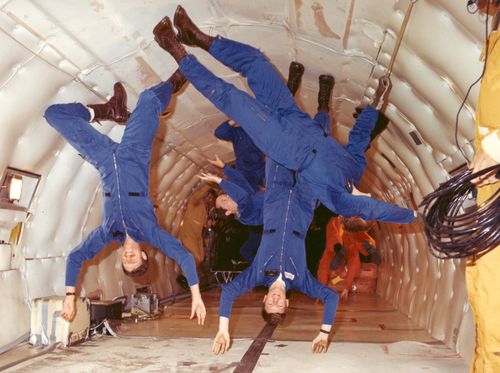
Watch Felix Baumgartner's supersonic freefall back to Earth. He experienced free-fall or weightlessness.
A note on Weightlessness
The term weightless causes a lot of confusion for learners. The confusion of a person's actual weight with one's feeling of weight is the source of many misconceptions. Weightlessness refers only to someone's sensation of their weight, or lack thereof. Weightlessness is a feeling experienced by someone when there are no external objects touching the person exerting a push or pull upon them, (we call these contact forces because they arise due to things being in contact or touching each other).
The weight of a person is the force of gravitational attraction to the Earth that person experiences. Someone in free-fall, feels weightless but they have not lost their weight. They are still experiencing the Earth's gravitational attraction.
Learners are also often confused as to why astronauts in orbit around the Earth float in their spacecraft. One common misconception is that there is no gravity in space and so the astronauts can float. In actual fact, in low Earth orbit the Earth's gravity is about 90% of its strength at the surface of Earth. The only reason the astronauts float is because they are in free-fall and their spacecraft is also in free-fall with them, falling at the same rate. Therefore, the astronauts appear to float when compared with the spacecraft because they are both falling at the same rate. Another example is how orbiting spacecraft are essentially in free-fall as there is 'nothing' retarding their motion towards to centre of the Earth, but because of their orbital velocity, they never actually move closer to the Earth.
A great link to a video of someone experiencing free-fall is given in the Visit box.
Magnetic forces
- magnet
- magnetic material
- alloy
Certain materials have strong magnetic fields around them. These are called magnets. All magnets have two poles, a north and a south pole.
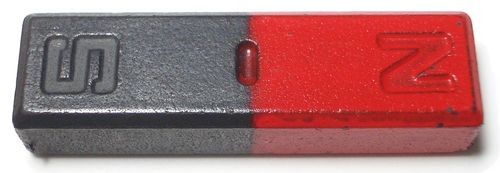
Other materials are strongly attracted to magnets. These materials are said to be magnetic. Magnets exert forces on other magnets and magnetic materials. Which materials are magnetic? Let's investigate.
Magnetic or non-magnetic materials
INVESTIGATIVE QUESTION: Which materials are magnetic and which are not?
HYPOTHESIS:
Write a hypothesis for this investigation.
Learner-dependent answer. There are many different possible hypotheses for this investigation. An example would be: Only some materials are magnetic.
MATERIALS AND APPARATUS:
- bar magnets
- paper
- wood
- plastic
- iron
- aluminium
- steel
METHOD:
- Hold the different items close to the bar magnet (not touching) to see if they are attracted to the magnet.
- Complete the table indicating whether or not the items are attracted to the magnet.
Learners should notice that the non-metals are not attracted to the magnets and that the copper, even though it is a metal, is not attracted.
How to destroy a magnet.
RESULTS:
Complete the following table.
|
Material |
Magnetic (YES/NO) |
|
paper |
|
|
wood |
|
|
plastic |
|
|
iron |
|
|
aluminium |
|
|
steel |
|
|
copper |
|
Material |
Magnetic (YES/NO) |
|
Paper |
NO |
|
wood |
NO |
|
plastic |
NO |
|
iron |
YES |
|
aluminium |
NO |
|
steel |
YES |
|
copper |
NO |
CONCLUSION:
What can you conclude from your results?
Not all materials are magnetic. Only some metals are magnetic, such as iron.
Not all metals are attracted to magnets. Those that are attracted to magnets are known as magnetic materials. There are very few magnetic materials. They are iron, nickel and cobalt. Alloys which include any of the magnetic materials can also be attracted to magnets. Steel is an alloy which contains iron so steel can be attracted to a magnet.
An alloy is a mixture of metals.
So now we know that magnetic forces can act over a distance, but can they still act if there is something in the way? Let's find out.
Can a magnetic force act through substances?
Magnetic forces are non-contact forces and can act over a distance. However, normal magnets do not have very strong magnetic fields. The further an object is from the magnet, the weaker the force experienced. A magnet should be able to act through most substances. If the object placed between the magnet and the metal is too thick, then the metal might be too far away from the magnet to experience a strong enough force. This lack of attraction is then due to the strength of the magnetic field and not the "blocking" ability of the material. In this investigation you can investigate this by using a thin piece of wood and a thick piece of wood. The magnetic field can act through the thin wood which means wood is not a "blocker" of magnetic force. So if the thick wood prevents the paper clips from being attracted it can be seen that it is the distance between the paperclips and the magnet which is relevant and not the material (wood).
MATERIALS:
- bar magnets
- paper
- thin piece of wood
- thick piece of wood
- foil
- paperclips
INSTRUCTIONS:
Hold two north poles close together. What do you notice?
The two poles repel each other. There is a "pushing" force.
Hold two south poles close together. What do you notice?
The two poles repel each other. There is a "pushing" force.
Hold a north pole and a south pole close together. What do you notice?
The two poles attract each other. There is a pulling force between the poles.
The magnet should work through any of the materials, as long as they are thin enough. It is the distance between the magnet and the paper clips that will affect the attraction. So the thin piece of wood should not prevent the attraction but the thicker wood will keep the paper clips far enough away from the magnet to make the attraction too weak to pick up the paper clips.
QUESTIONS:
Were there any materials which prevented the magnet from picking up the paper clips.
The only material which may have prevented the magnet from picking up the paper clips is the thick piece of wood.
What does this activity tell us about the nature of the magnetic force?
It acts over a distance. It is strongest closer to the magnet and weaker as you move further away from the magnet.
In the last activity we saw that like poles repel each other but opposite poles attract each other. We have also seen that the magnetic force acts over a distance. The magnet does not need to touch something in order to exert a force on it. So a magnetic force is a non-contact or a field force.
What is a force field? Can we see it? Let's investigate if it is possible to see a magnetic field.
What is the magnetic field?
Visualising magnetic fields
The iron filings align with the magnetic field. Explain to the learners that the iron filings show a two dimensional view of the field but the field is actually all around the magnet, in three dimensions.
MATERIALS:
- iron filings
- two bar magnets
- paper
INSTRUCTIONS:
- Put the bar magnet on the table.
- Put the paper over the magnet.
- Shake the iron filings onto the paper.
- Use your finger to slowly push the filings around the magnet.
- Take note of the pattern and draw it below.
This shows the pattern around a bar magnet.
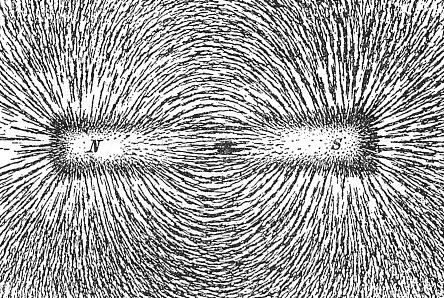
- Lift the paper away from the magnet.
- Place a second magnet next to the first so that different poles are facing each other.
- Put the paper back over the magnets.
- Move the iron filings around the two magnets, especially between the magnets.
- Draw the pattern in the space below.
The pattern between two opposite poles attracting.
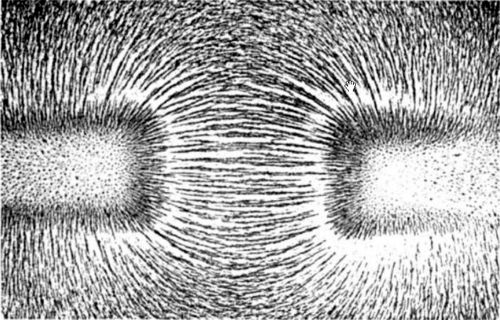
- Lift the paper away from the magnet.
- Move the second magnet so that the same poles are facing each other.
- Put the paper back over the magnets.
- Move the iron filings around the two magnets, especially between the magnets.
- Draw the pattern in the space below.
The pattern between two like poles repelling.
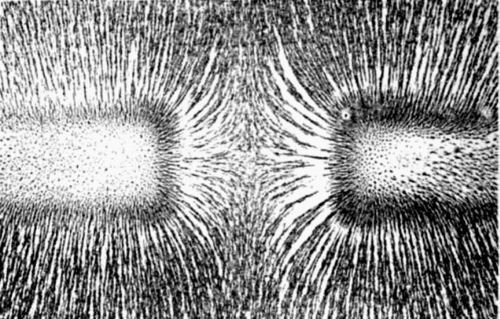
As we have seen, it is possible to visualise the magnetic force field around a magnet. We know from our previous activities that the magnetic force acts over a distance. The field is the space around a magnet in which it can attract or repel another magnet.
In the last activity, the iron filings showed a two dimensional view of the field but the field is actually all around the magnet, in three dimensions.
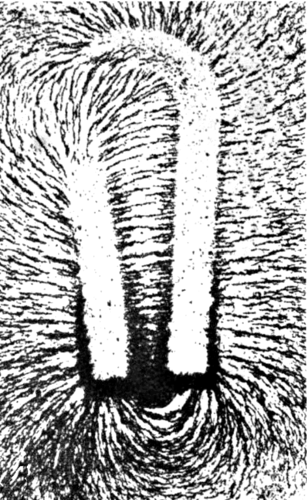
How do we draw a force field? The pattern you saw with your magnets can be represented by field lines. Field lines are used to show something we can't actually see. The closer the field lines are drawn together, the stronger the field being described. The more field lines that are drawn, the stronger the field. The field lines go from the north pole to the south pole. The following diagram shows the field lines around a bar magnet.
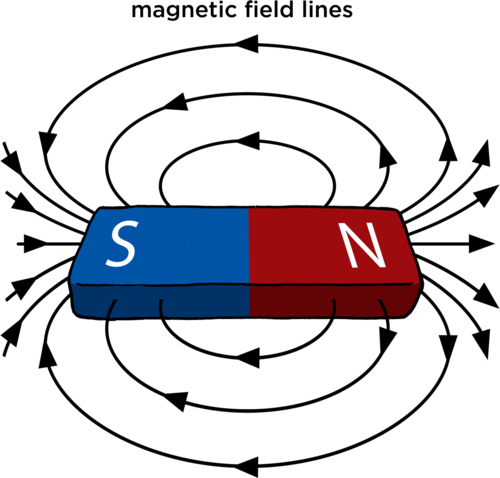
The next diagrams show the field lines between bar magnets which are attracting and those which are repelling.
Opposite poles attract.
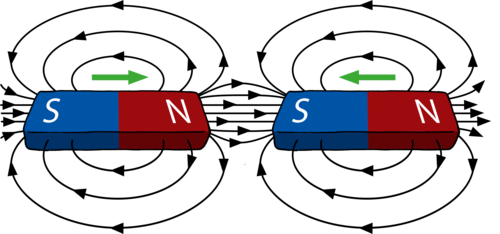
Like poles repel.
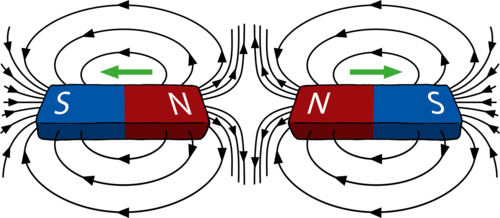
A field is strongest next to the magnet and gets weaker further away from the magnet.
Did you know that the Earth is like a bar magnet with a North and a South Pole? The Earth has a magnetic field. You can imagine Earth's magnetic field as though there is a bar magnet running through the core with the magnet's south pole under Earth's North Pole. No one knows for sure, but the theory is that the superhot liquid iron in the Earth's core moves in a rotational pattern, and these rotational forces lead to the weak magnetic forces around the Earth's rotational axis.
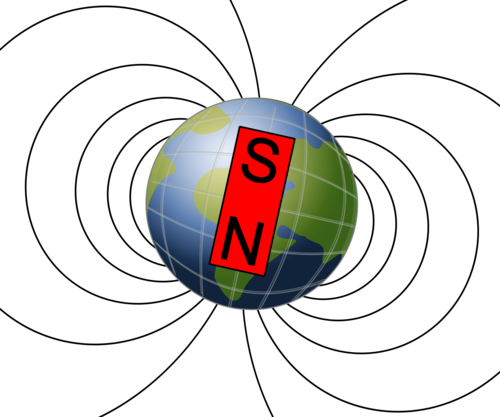
Earth's magnetic field. http://science.howstuffworks.com/environmental/29143-100-greatest-discoveries-earths-magnetic-field-video.htm
Where is the True North Pole.
This is why we can use compasses to tell direction. A plotting compass has a needle with a small magnet. The needle points to magnetic north because the small magnet is attracted to the opposite magnetic field and can be used to determine direction.
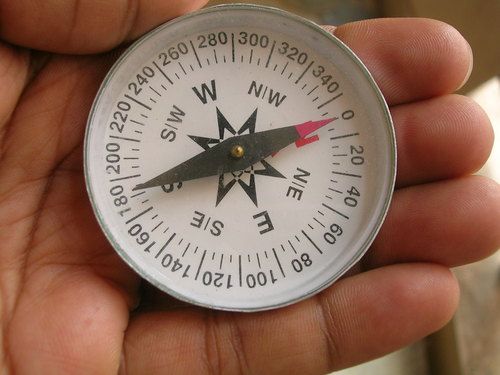
The Southern lights are also called the Aurora Australis and the Northern lights are called the Aurora Borealis.
Have you heard of the Southern or Northern Lights before? Do you know how this phenomenon occurs?
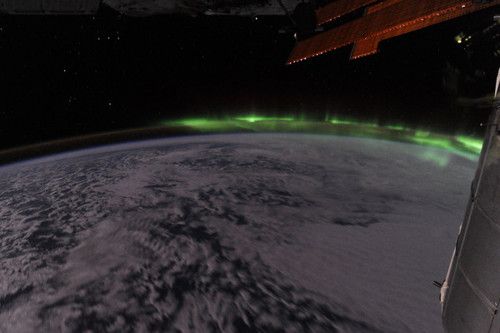
Charged particles escape from the surface of the Sun and move outwards in all directions. When the charged particles reach Earth, some are trapped by Earth's magnetic field in areas in space around Earth's atmosphere, called belts. Sometimes the charged particles escape the belts and spiral along the magnetic field lines towards the magnetic poles where they enter Earth's atmosphere. They then interact with atmospheric gas particles, causing beautiful light shows.
What causes the Northern Lights?
Some liquids can also become magnetised in the presence of a strong magnetic field. They are called ferrofluids.

Magnetic liquid (video).
Electrostatic forces
Do you remember learning about static electricity in Gr. 8? Let's do a quick activity to revise some of the concepts we already know.
Even though these experiments were done in Gr. 8, it is important for the learners to do them again as an activity. This will help them to understand how the electroscope and Van de Graaff generators work.
Charging objects
You can also do this activity using a plastic comb rather than balloons. Otherwise you can use pieces of paper instead of a learner's hair as not all hair will behave in the following way.
MATERIALS:
- balloons (or a plastic comb)
- glass rod
- piece of knitted fabric (wool)
- PVC rod
- plastic ruler
- small pieces of paper
- water tap
INSTRUCTIONS:
Hold the balloon a short distance away from your hair. What do you notice?
Nothing happens.
Now hold the balloon a short distance away from your hair. What do you see?
The hair should "rise" and stick to the balloon.
Next, hold the glass rod over the small pieces of paper. What do you notice?
Nothing happens.
Hold the glass rod over the pieces of paper. What do you notice?
The pieces of paper stick to the glass rod.
Hold the glass rod close to the stream of water. What do you notice?
The stream of water bends towards the glass rod.
QUESTIONS:
What did you do to make your hair stick to the balloon?
Rubbed it vigorously with the balloon.
What happens when you rub the glass rod with the knitted fabric?
Electrons are transferred from the glass rod to the knitted fabric because of friction. The glass rod becomes positively charged and the wool becomes negatively charged.
Why did the glass rod attract the stream of water?
The water has positive and negative charges. The negative charges were attracted to the positively charged rod.
Let's look at the example of brushing your hair in more detail to understand what is happening. You have dragged the surface of the plastic comb against the surfaces of your hair. When two surfaces are rubbed together there is friction between them. The friction between two surfaces can cause electrons to be transferred from one surface to the other.
In order to understand how electrons can be transferred, we need to remember what we learnt about the structure of an atom.
Where are the electrons positioned in the atom?
The electrons are positioned in the space around the nucleus.
What is the type of charge on a proton?
Positive charge.
What is the type charge on an electron?
Negative charge.
What is the charge on a neutron?
Neutrons are not charged. They are neutral.
The atom is held together by the electrostatic attraction between the positively charged nucleus and the negatively charged electrons. Within an atom, the electrons closest to the nucleus are the most strongly held, whilst those further away experience a weaker attraction.
Normally, atoms contain the same number of protons and electrons. This means that atoms are normally neutral because they have the same number of positive and negative charges, so the charges balance each other out. All objects are made up of atoms and since atoms are normally neutral, objects are also usually neutral.
However, when we rub two surfaces together, like when you comb your hair or rub a balloon against your hair, the friction can cause electrons to be transferred from one object to another. Remember, the protons are fixed in place in the nucleus and so they cannot be transferred between atoms. Only electrons can be transferred between atoms. Some objects give up electrons more easily than other objects. Look at the following diagram which explains how this happens.
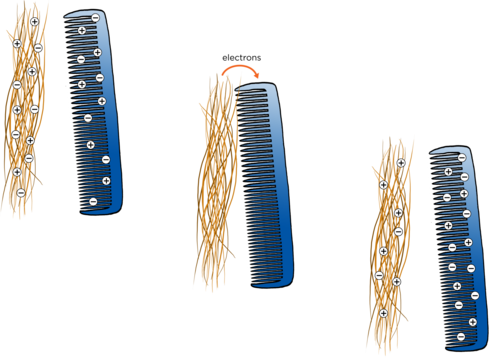
Which object gave up some of its electrons in the diagram?
The hair.
Does this object now have more positive or more negative charges?
It has more positive charges.
Which object gained electrons in the diagram?
The comb.
Does this object now have more positive or more negative charges?
It has more negative charges.
When an object has more electrons than protons, we say that the object is negatively charged.
When an object has fewer electrons than protons, we say that the object is positively charged.
Remember it is only the outer electrons which move, and not the protons which are located in the nucleus of the atom.
Have a look at the following diagrams which illustrate this.
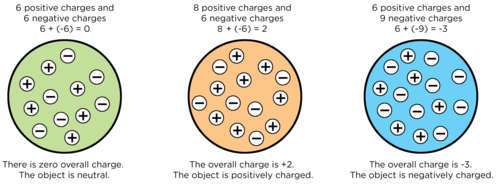
A simulation on friction between a carpet and John Travolta's foot. http://phet.colorado.edu/en/simulation/travoltage
We now understand the transfer of electrons that takes place as a result of friction between objects. But how did that result in your hair rising when you brought the charged balloon close to your hair in the last activity? Let's look at what happens when oppositely charged objects are brought together.
Turning the wheel
This is a fun demonstration of how like charges repel each other and unlike charges attract each other. If you have enough materials, allow the learners to try this themselves. If you don't have enough materials, do this as a demonstration but give the learners a chance to play a bit.
Practice this activity a few times first to make sure that you have the method right. Remember that it is quite easy to accidentally earth the rods so work with care. This will work best on a dry day. This will be dependent on the area in which you live.
At a brainstorming workshop with volunteer teachers and academics at the beginning of 2013, we filmed a quick demonstration of this task when the group was discussing it. You can view this short clip here: bit.ly/1fFbbbJ
MATERIALS:
- 2 curved watch glasses
- 2 perspex rods
- cloth: wool or nylon
- plastic rod
- small pieces of torn paper
INSTRUCTIONS:
- Place a watch glass upside down on the table.
- Balance the second watch glass upright on the first watch glass.
- Rub one of the perspex rods vigorously with the cloth.
- Balance the perspex rod across the top of the watch glass.
- Rub the second perspex rod vigorously with the same cloth.
- Bring the second perspex rod close to the side of the first perspex rod that was charged. What do you see happening?
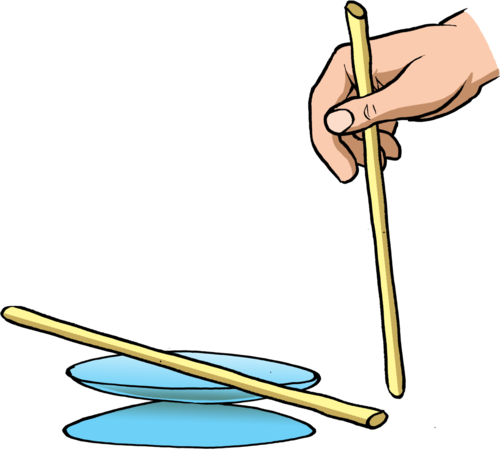
The second perspex rod should repel the first one as they have like charges, so learners should see the second rod 'pushing' the first one around in a circle.
You might need to rub the first perspex rod again, in between attempts, as the charge does dissipate.
- Repeat the activity but instead of the second perspex rod, use the plastic rod. What do you see happening?
The rods now have opposite charges and so the second rod should be seen to 'pull' the other rod around in a circle.
- Next, bring a rod that you have rubbed closer to small pieces of torn paper on the table. What do you observe?
The learners should be able to pick up the pieces of paper with the charged rod.
QUESTIONS:
What happened when you brought the second perspex rod close to the first perspex rod?
When the rods are the same (i.e. both perspex) then the first rod should move away from the second and the top watch glass will turn in a circle.
What happened when you brought the plastic rod close to the first perspex rod?
When the two different materials are used then the first rod should move towards the plastic rod and the watch glass will turn in a circle towards the plastic rod.
What happened when you brought the plastic rod close to the pieces of paper?
The pieces of paper were attracted to the rod.
When we rubbed the perspex rods with the cloth, electrons were transferred from the perspex to the cloth. What charge do the perspex rods now have?
A positive charge.
Both the perspex rods now have the same charge. Did you notice that objects with the same charge tend to push each other away? We say that they are repelling each other. It is an electrostatic force of repulsion.
When we rubbed the plastic rod with the cloth, electrons were transferred from the cloth to the plastic rod. What charge does the plastic rod now have?
A negative charge.
The perspex rod and the plastic rod now have opposite charges. Did you notice that objects with different charges tend to pull each other together? We say that they are attracting each other. It is an electrostatic force of attraction.
As with gravitational and magnetic force, the distance between charged objects affects the strength of the electrostatic force. The closer the charged objects are, the stronger the force. The more charged the objects are, the stronger the electrostatic force between them.
Discover more online with a simulation on rubbing balloons and a jersey. http://phet.colorado.edu/en/simulation/balloons
We have now observed the fundamental behaviour of charges. In summary, we can say:
- If two negatively charged objects are brought close together, then they will repel each other.
- If two positively charged objects are brought close together, then they will repel each other.
- If a positively charged object is brought closer to a negatively charged object, they will attract each other.
Remember,like charges repel and opposite charges attract.
Opposites attract and like repel (video)
Have you ever wondered where lightning comes from? Let's demonstrate an electrostatic spark.
Van de Graaff generator
This is an optional, extension activity. The Van de Graaff generator can be used for all sorts of fun activities. You can use it to explain various static electricity concepts. There are several websites with ideas and suggestions for fun activities and videos of demonstrations, such as this one: http://www.nationalstemcentre.org.uk/elibrary/resource/2088/van-de-graaff-generator
The purpose of this activity is to show how sparks are made so that you can go on to explain how lightning works. If you do not have a Van de Graaff generator then use a video clip (such as this oneprovided in the visit box) from the internet.
Big sparks, little sparks.
MATERIALS:
- Van de Graaff generator
INSTRUCTIONS
Bring the small metal globe close to the generator. What do you see?
The learners should see a spark between the generator and the globe.
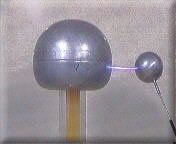
Did you see sparks? The Van de Graaff generator can be used to demonstrate the effects of an electrostatic charge. The big metal dome at the top becomes positively charged when the generator is turned on. When the dome is charged it can be discharged by bringing another insulated metal sphere close to the dome. The electrons will jump to the dome from the metal sphere and cause a spark.
The fundamental idea of using friction in a machine to generate a charge dates back to the 17th century, but the generator was only invented by Robert Van de Graaff in 1929 at Princeton University.
How does this little spark relate to a massive lightning strike?
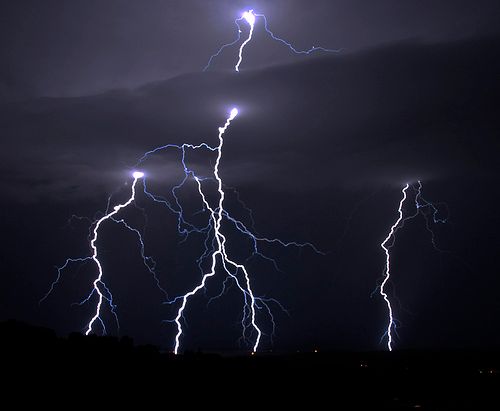
How to survive a lightning strike.
During a lightning storm, clouds become charged. Friction between the clouds and the moisture in the clouds cause the clouds to become charged. The bottom of the clouds (closest to the ground) become negatively charged and the top of the cloud becomes positively charged. When the build-up of charge becomes too large, the electrons move from the bottom of the cloud to the ground where they are "earthed". The energy transfer is massive and results in extremely bright light, heat and sound. A lightning flash is a massive discharge between charged regions within clouds, or between clouds and the Earth. The thunder-clap, which we hear, is the air moving as a result of electrons moving.
Lightning is extremely dangerous. If the electrons move through a person on their way to the ground, then the large amounts of energy cause significant damage. That person can suffer serious injury, even death.
South Africa has one of the highest incidences of lightning strikes in the world.
What precautions should we take during a lightning storm? Lightning can strike far from the rain shadow of the storm. This means that even if the storm seems to be far away, it is better to take precautions anyway. The safest place to be in a lightning storm is indoors. Stay away from windows and metal objects. If you cannot get inside, avoid standing next to tall objects or metal objects because if lightning strikes it will usually hit the tallest object in the area. If you are travelling in a car during a storm, stay inside the car until the storm subsides.
Summary
- A force is defined as a push or a pull on an object.
- Forces are measured in newtons (N).
- A force can change the shape, direction and motion of an object.
- Forces act in pairs. The force acting on the object is called the action and the force that the object exerts back in the opposite direction and equal in magnitude is the reaction.
- More than one force can act on an object. The net or resultant force is the sum of all the forces acting on the object.
- The forces acting on a body can be represented as a free-body diagram where the arrows indicate the direction and magnitude of the different forces.
- There are two main groups of forces; contact and non-contact (field) forces.
- Contact forces act when objects are in contact (touching) with each other. Friction, tension and compression are examples of contact forces.
- Friction is the force opposing motion between two surfaces as they rub against each other.
- Compression forces are two forces acting on one object, moving in opposite directions (towards each other) to compress or deform the object.
- Tension forces are two forces acting on one object, moving in opposite directions (away from each other) to stretch the object.
- Non-contact forces can act over a distance and objects do not have to be touching each other. Common examples of field forces are magnetic, electrostatic and gravitational forces.
- Non-contact forces are known as field forces. A field is a region in space where a certain object with certain properties will experience a force.
- Gravitational force is a force of attraction between two bodies due to their mass. The gravitational force increases with mass and decreases with the distance between the bodies.
- The weight of a body is the gravitational force exerted on an object by the Earth (or Moon or other planet). The weight will vary depending on where it is measured.
- The mass of an object is a measure of how much matter it contains. The mass stays constant no matter where it is determined.
-
Weight is calculated as W = m × g, where g is the gravitational acceleration. On Earth, g = 9,8m/s2.
- A magnet is a material which has a strong magnetic field around it.
- Magnetic forces of attraction exist between a magnet and a magnetic substance, such as iron, steel, cobalt and nickel.
- A magnet has two poles, a north and south pole. Opposite poles attract each other and like poles repel each other.
- The Earth has a magnetic field around it. We can use compasses to tell direction as the needle is a magnet which points to magnetic North.
- When certain materials are rubbed together, the friction between them causes electrons to move from one material to the other. The objects then have an electrostatic charge, due to either the loss or gain of electrons.
- A charge is a fundamental property of matter. Electrons carry negative charges and protons carry positive charges.
- An object which has gained electrons will be negatively charged. An object which has lost electrons will be positively charged.
- There is an electrostatic force of attraction between objects with opposite charges, and repulsion between objects with like charges.
- Thunder clouds can become charged as the water and air particles rub against each other. A lightning strike occurs when there is a huge discharge between the thunderclouds and the ground.
- Lightning is dangerous and safety precautions should be adhered to during lightning storms.
Concept Map
Complete the concept map to summarise what you have learnt about forces in this chapter. You can also use the space around the concept maps to add some of your own notes on these to help form more comprehensive summaries. This will help you prepare for exams when you need to revise everything from the year.
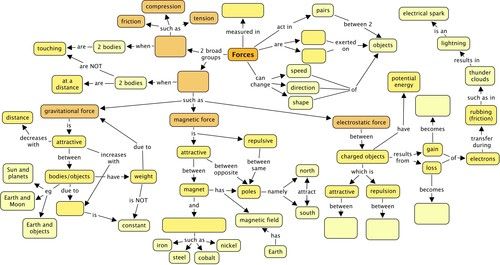
Teacher's version
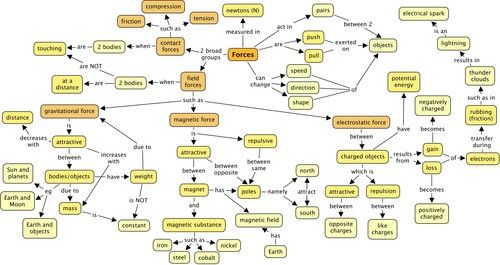
Revision questions
Give one term for each of the following descriptions. [5 marks]
-
An influence that can deform a flexible object or change the motion of an object with mass.
-
A region in space where an object with certain properties will experience a force.
-
When the only force acting on an object is the force due to gravity.
-
The two opposite ends of a magnet.
-
A fundamental property of matter that comes in two types and is carried by protons and electrons.
-
Force.
-
Field.
-
Free-fall
-
Poles.
-
Charge.
Four possible answers are given for each of the following questions. There is only one correct answer. Write the letter on the line below each question. [6 x 2 = 12 marks]
-
Which ONE of the following statements is FALSE?
A. In order for a non-moving object to start moving, a net force must act on that object.
B. Contact forces are strongest when the objects experiencing the force are touching.
C. Field forces act over distances, but they can also act when objects are touching.
D. Forces always act in pairs of equal strength, but these pairs act on different objects.
-
Which ONE of the following is NOT a field force?
A. Gravitational force
B. Frictional force
C. Electrostatic force
D. Magnetic force
-
The correct unit for gravitational force is:
A. the newton
B. the kilogram
C. the newton per kilogram
D. the kilogram per newton
-
Which ONE of the following substances is magnetic?
A. aluminium
B. copper
C. cobalt
D. tin
-
The electrostatic force between two charged objects is F. The distance between them is increased. How does the electrostatic force change?
A. It increases
B. It decreases
C. It remains the same
D. Not enough information has been provided.
-
An astronaut has a mass of 80 kg on Earth. Which ONE of the following regarding mass and weight of the astronaut on the Moon is correct?
A. The mass will be the same and the weight will also be the same.
B. The mass will be less and the weight will also be less.
C. The mass will be the same and the weight will be less.
D. The mass will be less and the weight will be the same.
-
B
-
B
-
A
-
C
-
B
-
C
-
A force cannot make a motionless object move.
-
A force can make a moving object change direction.
-
A force can change the shape of an object.
-
A tension force slows down or stops an object because of the surfaces rubbing against each other.
-
Lightning is an application of a magnetic force.
-
False. A force can make a motionless object move.
-
True
-
True
-
False. A friction force slows down or stops an object because of the surfaces rubbing against each other
-
False. Lightning is an application of an electrostatic force.
Have a look at the following images.
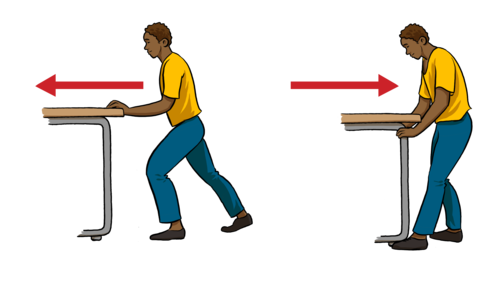
-
Which situation shows a push and which situation shows a pull? [1 mark]
-
The boy is pulling the desk with a force of 70 N. There is a frictional force of 20 N. Draw a free body diagram in the space below to show these forces acting on the desk. [4 marks]
-
What is the net force acting on the desk? [1 mark]
-
The image on the left shows a push and on the right shows a pull.
-
1 mark is allocated to drawing a dot for the desk.
1 mark is allocated for the correct values used.
2 marks are allocated to the correct direction of the arrows and the arrow lengths to show the difference in magnitude of the forces.

-
50 N to the right.
A force of 50 N and 80 N act on a block. Calculate the net force acting on the block if:
-
the forces are acting in the same direction [1 mark]
-
the forces are acting in opposite directions [1 mark]
-
110 N
-
30 N
Write down three different effects that a force can have on an object. [3 marks]
- change in motion (faster or slower)
- change in direction
- change in shape
What is the following diagram illustrating? Explain your answer. [4 marks]
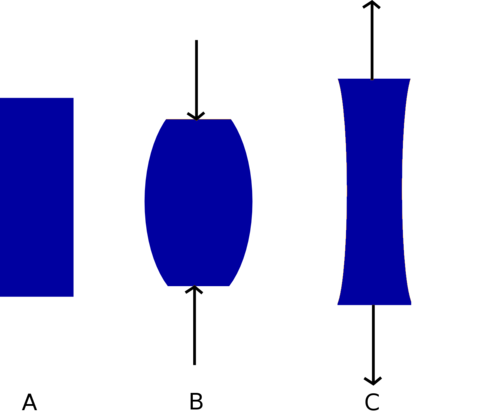
Image A shows the object at rest and image B and C shows the object with different forces applied to it. Image B shows compression forces applied to compress the object. Image C shows tension forces applied to stretch the object.
Tabulate the distinction between mass and weight by making use of definitions of mass and weight and comparing the units they are measured in. [5 marks]
Table showing the difference between mass and weight.
|
Mass |
Weight |
|
|
Definition |
Mass is determined by the amount of matter that an object is made up of, and it remains constant no matter where it is measured. |
The weight of an object is determined by the gravitational force exerted on it by the Earth or other large object, such as the Moon or another planet. The weight varies depending on where it is determined and the strength of the gravitational force. |
|
Units |
kilograms (kg) |
newtons (N) |
Write down the formula that relates the weight of an object to its mass. Explain what each symbol represents. [4 marks]
W = m × g, where W is the weight of the object in N, m is the mass of the object in kg and g is the gravitational acceleration in m/s2.
What TWO factors affect the gravitational force experienced between two objects? Explain the relationship. [2 marks]
The distance between the objects, as the closer they are, the stronger the force, and the mass of the objects as the greater the mass, the stronger the force.
An astronaut performs an experiment to determine the relationship between mass and weight on different planets. He takes a scale and sets off in a spaceship and measures his own weight on different planets in the solar system. The following table indicates his results.
|
Planet |
Weight (N) |
|
Mercury |
287 |
|
Venus |
710 |
|
Earth |
? |
|
Mars |
302 |
|
Jupiter |
2076 |
|
Saturn |
886 |
|
Uranus |
854 |
|
Neptune |
1126 |
-
Calculate the astronaut's weight on Earth if his mass is 80 kg. [3 marks]
-
Plot an appropriate graph of the astronaut's weight on different planets of the solar system. Your graph will need a suitable heading and labels for the axes. [8 marks]
-
On which planet is Kevin's weight the smallest? What does this tell you about the size of this planet in relation to the other planets? [2 marks]
-
Learners must provide the formula, then substitute with the values and provide the answer with the units.
W = m × g
= 80 x 9,8
= 784 N
-
Learners must draw a bar graph with gaps between the bars [2 marks], provide a heading [1 mark], x-axis label [1 mark], y-axis label with units [1 mark], appropriate vertical scale [1 mark], accuracy of plotting [2 marks].
-
His weight is the smallest on Mercury as Mercury is the smallest planet in mass.
Draw a diagram to illustrate the magnetic field around a bar magnet. [3 marks]
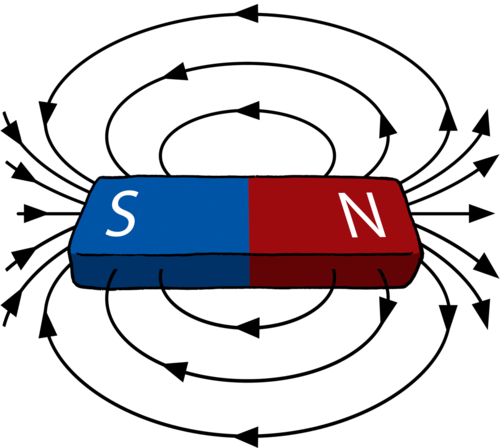
You do an experiment in class to investigate the bar magnets. You place two magnets next to each other on the table and place a sheet of paper over the magnets and sprinkle iron filings over the paper. You then turn one magnet around and do it again. You see the following patterns. What does each photo (A and B) show us? [2 marks]
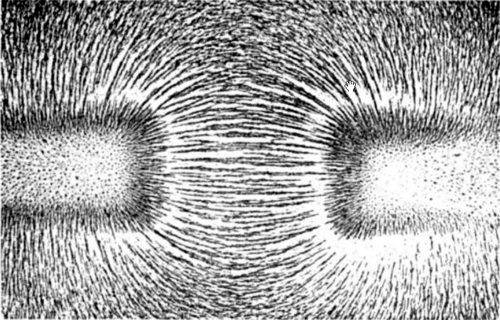
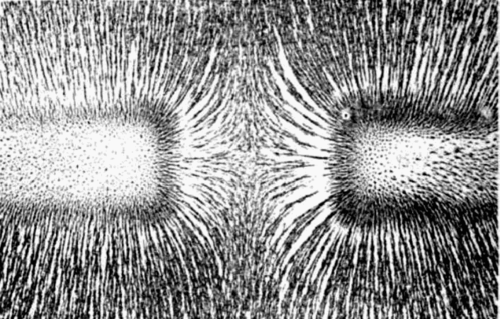
Photo A shows the magnetic field between two opposite poles which are attracting each other. Photo B shows the magnetic field between two like poles (either north and north or south and south) which are repelling each other.
|
Object |
Overall charge |
Why is it positive, negative or neutral? |
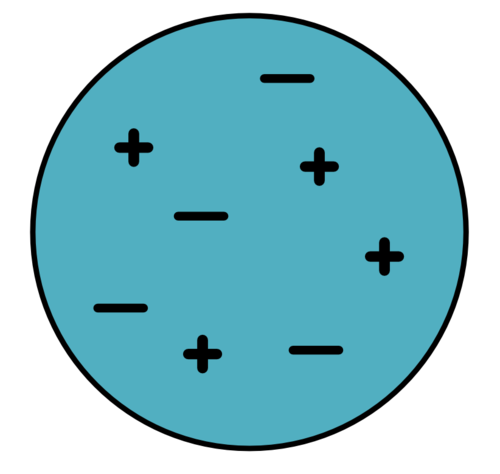 |
||
 |
||
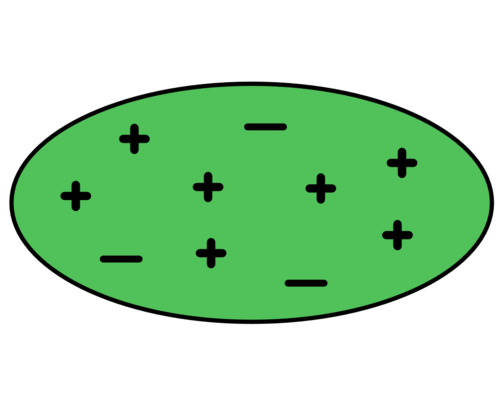 |
3 marks for each of the objects, 1 mark is awarded to the calculation and 2 marks to the explanation.
|
Object |
Overall charge |
Why is it positive, negative or neutral? |
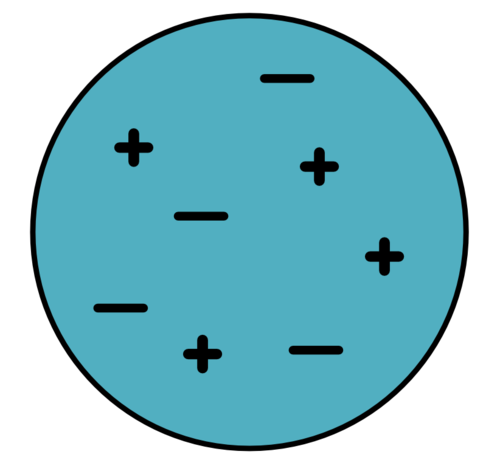 |
Charge = 4 + (-4) = 0 |
It is neutral as there are equal numbers of positive and negative charges. |
 |
Charge = 3 + (-6) = -3 |
It is negatively charged as there are 3 more negative than positive charges. |
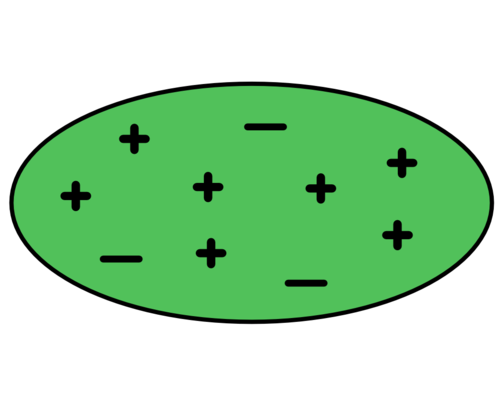 |
Charge = 7 + (-3) = 4 |
It is positively charged as there are 4 more positive charges than negative charges. |
A balloon is rubbed against a jersey and the balloon picks up a negative charge.
-
Explain where this negative charge comes from. Make reference to both protons and electrons in your answer. [3 marks]
-
Name the type of force that the balloon and jersey will experience DURING rubbing. [1 mark]
-
Name the type of force that the balloon and jersey will experience AFTER rubbing. [1 mark]
-
Will the force referred to in (c) be attractive or repulsive? [1 mark]
-
Electrons are transferred from the jersey to the balloon. Protons are not transferred. Electrons are negatively charged and thus the balloon picks up a negative charge.
-
Friction.
-
Electrostatic force.
-
Attractive.
What do you think these two girls are touching on the left of the photo? Explain your answer and what is happening to them. [3 marks]
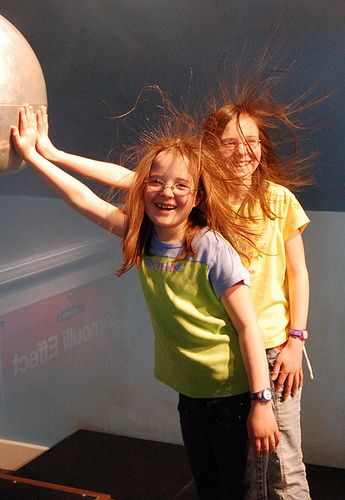
The girls are touching the hollow dome of a Van de Graaff generator. The dome is positively charged so electrons are transferred from their bodies to the dome to discharge it. This causes their bodies and hair to become positively charged. Their hair strands now repel each other as they are all positive (like charges repel) and they rise up.
Friction between the water and air particles in the clouds causes a build-up of negative charge. When there is a large excess charge in the clouds, the excess charge moves through the air to the ground and discharges. This discharge forms a bright spark as the energy which is released by the moving charges is in the form of heat, light and sound. This is lightning.
What is wrong with the following scene? Explain your answer. [2 marks]
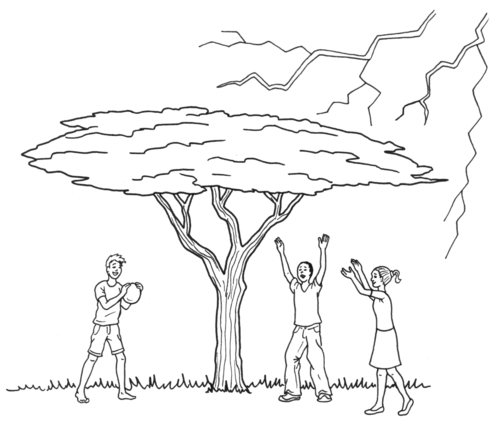
The learners are playing outside during a lightning storm, which is dangerous. Furthermore, they are underneath a tree, which is even more dangerous as the lightning strikes tall objects, such as trees, and so they are at risk of getting shocked.
Total [94 marks]
